Youth HONG KONG

a quarterly journal from the hongkong federation of youth groups March 2023 Volume 15 Number 1
OVERVIEW
4 Opportunities to Close the Health Gap

INTERVIEW
6 Primary Healthcare for Better Quality of Life

9 Addressing Hong Kong’s Health Gap
YOUTH SPEAK
12 In the Search for Healthy and Balanced Lifestyles
SPECIAL FOCUS
17 Efforts on Sodium and Sugar Intake Prevention

PROFESSIONALS’ SPEAK
21 From “I Am” to “We Are”
23 Building up Resilience and Beating Stress

SPECIAL FOCUS
25 Tele-medicine as the “New Normal”


YOUTH WATCH
27 Prevalence of Obesity Globally
PUBLICATIONS
30 Ready Report: Effectively Supporting SEN Secondary Students with e-Learning
HOMECOMING
33 Home is where Hong Kong’s nature is!
FEATURE
36 The Importance of Health and Nutrition in Adolescents
38 Sustainable and Climate-friendly Ways of Travelling
HKFYG NEWS
40 New Webisodes from “With All Our Might” Series
42 Striking a Chord at this year’s Hong Kong International a cappella Festival 44
Youth Hong Kong
March 2023
Volume 15 Number 1
YOUTH HONG KONG published quarterly by The Hong Kong Federation of Youth Groups
EDITORIAL BOARD
Andy Ho (Chair)
Lakshmi Jacota (Vice Chair)
Ada Chau (Managing Editor)
Gwen Sin (Senior Editor)
Hsu Siu-man

Miranda Wong
Christa Cheung
Winky Ang
Miranda Ho
CIRCULATION (unaudited)
9,000 in Hong Kong, throughout the region and overseas
VIEWS EXPRESSED are the authors’ and interviewees’, may come from official sources, and do not necessarily reflect the views of the editorial board or publisher

REPRODUCTION OF CONTENTS without written permission from the publisher is prohibited
OVERVIEW
Lakshmi Jacota
SECTIONS & TRANSLATION
Gwen Sin, Ada Chau and CPS team PHOTOGRAPHS
Gwen Sin, stock images or in public domain TRADEMARKS All brand names and product names are registered trademarks. Youth Hong Kong is not associated with any product or vendor mentioned in articles.
ARTWORK & DESIGN
Roda Asia Ltd. & HKFYG
COVER DESIGN
Roda Asia Ltd.
LAYOUT & PRINTING DG3
ISSN 2071-3193 (Print)
ISSN 2519-1098 (Online)
WEB youthhongkong.hkfyg.org.hk
CORRESPONDENCE to The Editor, Youth Hong Kong, 21/F, The Hong Kong Federation of Youth Groups Building, 21 Pak Fuk Road, North Point, Hong Kong
TEL 3755 7108
FAX 3755 7155
EMAIL youthhongkong@hkfyg.org.hk
ADVERTISING ENQUIRIES
Ada Chau 3755 7108
The Hong Kong Federation of Youth Groups was founded in 1960 and is the city’s largest youth service organization. More than 25,000 activities are organized by over 80 units annually with attendance of nearly 6 million.
Services Camps, Leisure, Cultural and Sports Services, Counselling, Creativity education and STEM, Education and continuous learning, Employment and entrepreneurship, Exchange, Leadership training, M21 Multimedia, Parenting, Research and Publications, Volunteering, Youth at Risk, Youth SPOTs
WEB hkfyg.org.hk m21.hk
Online donations giving.hkfyg.org.hk
Contents 2
“Inno
Awards Presentation Ceremony Announced
Winning Teams
“Youth Development Blueprint” Post-Announcement Dialogue by M21
Community Engagement through Project Neighbourhood First
All-In-one Learning Environment with Easy School Connect
HKFYG 2023 to 2024 Annual Plan 4-5 OVERVIEW 6-11 INTERVIEW 12-16 YOUTH SPEAK 21-24 PROFESSIONALS’ SPEAK 17-20 SPECIAL FOCUS 33-35 HOMECOMING 30-32 PUBLICATIONS 27-29 YOUTH WATCH 25-26 SPECIAL FOCUS 36-39 FEATURE 40-50 HKFYG NEWS
Impact”
Five
47
48
49
50
The impact of more than three years of the global pandemic cannot be underestimated. From resultant deaths, illnesses, debilitating long-Covid recuperations, and the numerous vaccination, mask, social distancing and even lockdown protocols, we have all had to re-think the way we live, work and interact. It is no wonder, therefore, that we’re all paying more attention to issues surrounding health and wellbeing.
However, what we have also been reminded of during this period – and it is not something new – is that there is gap in how, where and when people can access and afford health care.
This issue of Youth Hong Kong looks at the reasons for this health gap and the different ways in which we can take steps to close this divide, especially considering new ways for young people to get involved beyond just being medically trained professionals.
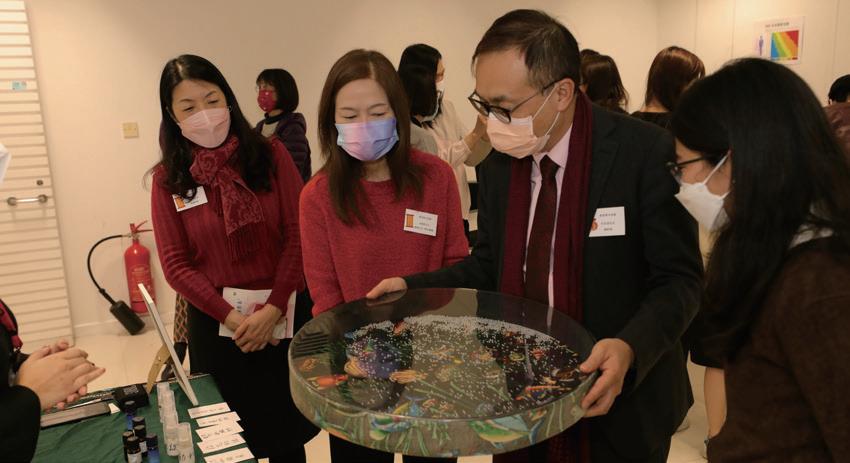
We know that this is not a unique situation to Hong Kong, and would very much like to hear your thoughts and experiences surrounding the health gap.
Andy Ho Wing-cheong Executive Director, HKFYG March 2023
Editorial 3
Opportunities to Close the Health Gap
Lakshmi Jacota
Health is not simply the absence of disease, but encompasses the gamut of physical, mental and social wellbeing. Hong Kong has one of the highest ranked health indices in the world, but there are challenges, not only as a consequence of an aging population, but because of other factors as well. What are the determinants that we need to consider when we speak about a health gap?
We live in what many call the golden age of health care. We are now quite used to hearing about constant advancements is medical technology along with cutting edge research and experimentation that heals and cures, extends life expectancy and reduces infant mortality. It is not unfamiliar to read about common diseases – and new pandemics – that can be vaccinated against. So then, what do we mean when we talk about disparities in health equality and equity, otherwise known as a health gap?
Perhaps the best starting point is to clear up the distinction between health inequality and health inequity. According to The Lancet , the former “simply describes a difference between two measurements of the same indicator” 1 [for example, maternal health, mortality or prevalence of diseases], while the World Health Organisation defines health inequity as “a systematic difference in the health status of different population groups.”2


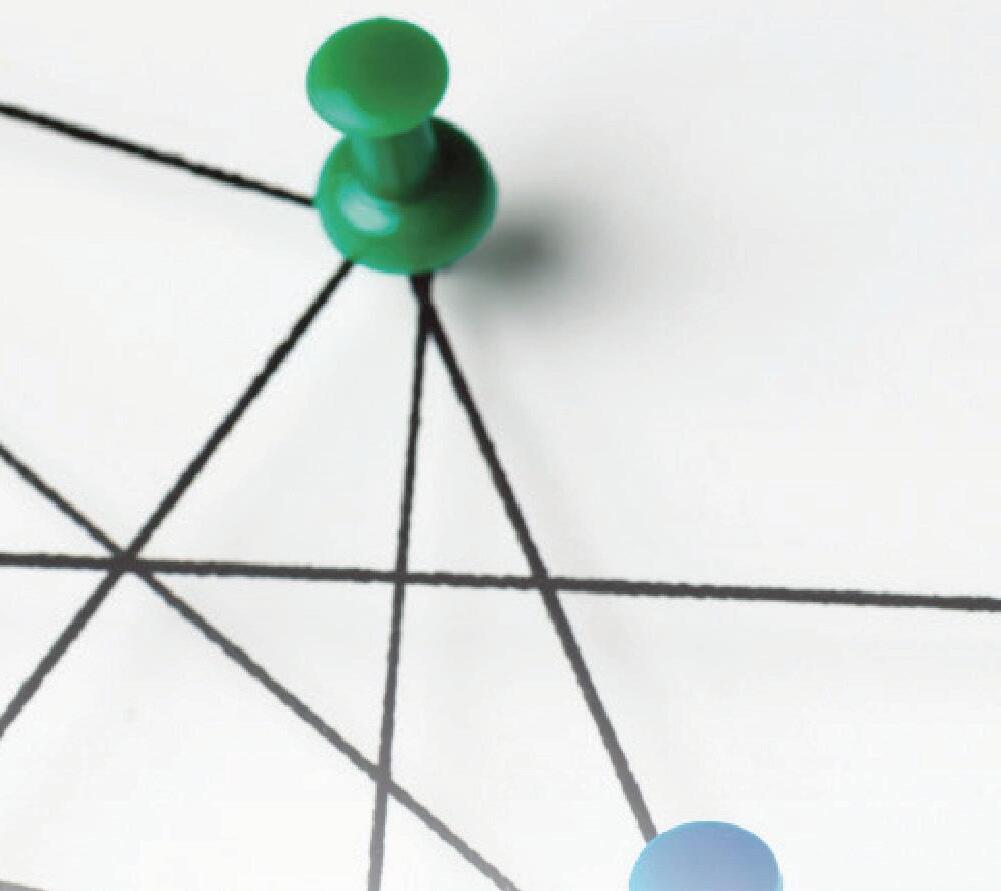
In other words, these definitions force us to look at the issue of a health gap as one based on advantage and disadvantage; those who have and can access health care and who can afford it, vis-à-vis those who cannot. Inequity clearly suggests that there are social, economic and

sometimes even political features that can impact overall health, whether physical, emotional or mental. These factors can include, but are not exclusive to, the availability of safe housing, clean water, healthy food, education and medical care. Health inequity, as many have argued, goes beyond health management exclusively, but which requires changes in government policy to become more holistic in order to balance out potential and avoidable differences in order to overhaul a country’s or city’s health status.
Look at the issue of a health gap as one based on advantage and disadvantage.
In fact, there is a stark reminder that health inequity is not something unique to low income countries, but is very apparent within communities as well, with Hong Kong being no exception. As The Chinese University of Hong Kong (CUHK) Institute of Health Equity (IHE) pointed out, data from as early as the Department of Health’s own Population Health Survey 2014/15 indicated, there has been “a gradient of self-rated health among
4 Overview
different groups of household income … [meaning] that households with higher income are more likely to consider their health good or excellent than as poor or fair.”3
The Institute specifically points out the inequality of particular factors in Hong Kong that have aggravated measures of health inequity. These include: education; one of the lowest minimum wages among many developed countries; a high Gini coefficient which measures income distribution; unaffordable housing; an aging population and, most obviously, the long waiting time for publicly funded out-patient services, leaving “those who are poor and deprived … less likely to have regular sources of primary [health] care, irrespective of the number of chronic diseases or other sociodemographic factors.” 4
While COVID might have exacerbated health inequities, the global pandemic cannot be used as the sole reason for the worsening health gap, both in Hong Kong and around the world. So, given this grim scenario, what can be done to rectify this situation?
In January this year, the World Economic Forum put out a report5, in which it was argued that for broader outcomes across health and wellness to be obtained, innovations and investment in healthcare must be done in combination by addressing cross industry collaboration and public-private partnerships. This is because health care relies also on the maintenance of healthy lifestyles, while also reducing risk factors that are very often explicitly ‘non-medical’.
As the CUHK IHE clearly states, the government must work with other sectors, “including academia, social care and healthcare, professional bodies, businesses, charities and voluntary organisations, in developing policies across the board to mitigate the social determinants of health inequalities and alleviate the burden of disease on disadvantaged groups.”6 This is not a new strategy, but one that certainly has to gain more traction if we are to deal with health inequities seriously. Therefore, to advocate for the concerted efforts of a diversified inter-sectoral approach – not only in treatment, but in prevention and control as well – becomes something to which a youth organisation like the Federation can readily commit.
One current initiative of the Federation, for example, is the Wellness Plus Complex. This health and wellness complex, obtained after renovating a kindergarten premises in a rather disadvantaged district in Hong Kong, Sham Shui Po, now serves as a platform to engage young people, as it encourages positive behaviour and empowers them to contribute to primary health care in the community. The Complex extends the services to all-rounded health through lifestyle modifications, which include interventions on nutrition, physical activity, stress management, sleep quality, risky behaviour and making social connections. What the creation of Wellness Plus Complex has done is establish a new service foundation for the Federation, making a very tangible effort at addressing health inequity through its contribution to creating a healthy society in a deprived community with all-round wellness.
Similarly, global digital investments reached nearly US$57 billion in 2021, particularly in tele-health and mental health, two areas in which the Federation not only has services, but encourages young people to get involved. What tele-health does is alleviate pressure on health care systems by offering on-demand primary health care, allowing a greater access to a greater number of people. This global effort must be both embraced and celebrated.
There are many other ways and initiatives, ongoing and to be launched. What we all know is that not one single person on earth is immune from health issues. But what makes the closing of the health gap a real possibility is when every organisation, civil society, government and business can play to its strengths to generate equitable standards for the overall health of a population Only by prioritising “actions, products, programmes and policies that promotes wellbeing”7 can the journey of closing the health gap begin.
References:
1. “Bridging the global health gap”, The Lancet, editorial, Vol.4 Issue 9 es579, September 2016. Available at https://www.thelancet.com/journals/langlo/article/PIIS2214-109X(16)30190-5/fulltext
2. Health inequities and their causes. World Health Organisation, 22 February 2018. Available at https:// www.who.int/news-room/facts-in-pictures/detail/health-inequities-and-their-causes
3. Explainer on Health Equity. CUHK Institute of Health Equity, Available at https://www.ihe.cuhk.edu. hk/explainer-on-health-equity/
4. ibid
5. Global Health and Healthcare Strategic Outlook: Shaping the Future of Health and Healthcare. World Economic Forum, January 2023. Available at https://www.weforum.org/reports/global-health-andhealthcare-strategic-outlook-shaping-the-future-of-health-and-healthcare
6. Build back Fairer: Reducing Socioeconomic Inequalities in Health in Hong Kong. CUHK Institute of Health Equity. Available at https://www.ihe.cuhk.edu.hk/wp-content/uploads/Health-EquityReport-01-1-1.pdf
7. Shaping a more equitable world for health and wellbeing. World Economic Forum. Available at https:// initiatives.weforum.org/global-health-equity-network/home
5
The global pandemic cannot be used as the sole reason for the worsening health gap.
Primary Healthcare for Better Quality of Life






 Prof Chung-Mau Lo Secretary of Health of the Government of Hong Kong
Prof Chung-Mau Lo Secretary of Health of the Government of Hong Kong




Hong Kong has the longest life expectancy in the world which can partly be attributed to an effective and efficient public and private healthcare system of very high professional standards. Nonetheless, facing major challenges brought about by a rapidly ageing population and the increasing prevalence of chronic diseases, the overloaded situation of the public healthcare services, with long waiting times, will only be further aggravated if there is no fundamental reform.
Over the past three years, the COVID-19 pandemic has further demonstrated the critical importance of a strong primary healthcare infrastructure and workforce within the community. At the same time, it has also exposed and exacerbated the financial burden on our healthcare system and the social costs of chronic diseases. A robust primary healthcare system will be an important line of defence against a wide range of potential public health crises.
Meanwhile, the Government attaches great importance to the mental health of the public under the epidemic, and understands that the COVID-19 epidemic has posed considerable challenges not only on the physical but mental well-being of the public.














Hence, the Government has adopted an integrated and multidisciplinary approach towards mental health, including promotion, prevention, and early identification, as well as timely intervention and treatment, and rehabilitation for persons in need. We have introduced initiatives that address the mental health needs that have arisen under the COVID-19 epidemic. For instance, we earmarked $300 million under the Beat Drugs Fund and launched the “Mental Health Initiatives Funding Scheme” in 2021 so as to provide better support to the needy in the community and to raise public awareness of mental health amidst the epidemic.



With its longevity, Hong Kong has one of the most rapidly ageing populations in the world and the speed of ageing will peak in the upcoming decade. Ageing is also associated with increasing health and social care needs and a higher prevalence of chronic diseases. The number of Hospital Authority (HA) patients with chronic diseases is projected to reach three million by 2039. More alarmingly, a substantial number of patients with chronic diseases – believed to be as many as a double the diagnosed number – remain undiagnosed and unmanaged. Diabetes Mellitus (DM) and Hypertension (HT) are most prevalent diseases especially among the aged.

6 Interview
Arobust primary healthcare system will be an important line of defence against a wide range of potential public health crises.
The ageing population and the increasing prevalence of chronic diseases will exert a heavy toll on secondary/tertiary care, especially in public hospitals [and] the utilisation rate of hospital services will rise exponentially for people aged 65 and over. Despite only making up 18% of the population, they already accounted for around half of all inpatient days and accident and emergency admissions, as well as over onethird of General Out-patient Clinic (GOPC) and Specialist Out-patient Clinic (SOPC) attendances in 2019. Among GOPC, Family Medicine Specialist Clinic and SOPC patients, around 60% had selected chronic diseases, of which 82% hade DM/HT. Among DM/HT patients, one in three had developed complications when just diagnosed, and their per capita service cost was two times higher than those without complications.
In the face of the pressure brought on by an ageing population and the increasing prevalence of chronic diseases, it is not possible to cope with the ever-rising healthcare demand solely through increasing public healthcare expenditure in public hospital services. Hence, we see the need to introduce a systemic reform of the healthcare system to shift the focus from treatment to disease prevention, to ensure healthy longevity for our people.
(1) Developing a community-based primary healthcare system;
(2) Strengthening primary healthcare governance;
(3) Consolidating primary healthcare resources;
(4) Reinforcing primary healthcare manpower; and


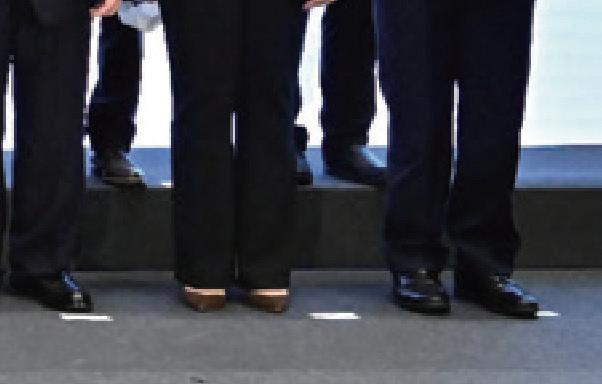

(5) Improving data connectivity and health surveillance.

Our vision is to improve the overall health status of the population, to provide accessible and coherent healthcare services, and to establish a sustainable healthcare system.

To achieve a healthy longevity, we need to shift the centre of gravity of our healthcare system from treatmentoriented-institution-centric-secondary/tertiary healthcare to prevention-oriented family-centric primary healthcare.
Under the guidance of the Steering Committee on Primary Healthcare Development (SCPHD), the Government launched the Primary Healthcare Blueprint (The Blueprint) on 19 December 2022 which sets out our vision, concrete recommendations and implementation plans, and outlines a strategic roadmap for the future development of primary healthcare in Hong Kong. The Blueprint puts forward five major directions of primary healthcare reform, including –

The current public healthcare system serves as an essential safety net for the population, especially those who lack the means to pay for their own healthcare. To optimise the utilisation of private healthcare resources and leverage on the private sector’s capacity for providing primary healthcare services, the Government has launched various government-subsidised or public-private partnership programmes in recent years with a view to tapping into private healthcare resources in meeting the demand for public primary healthcare service.

7
We see the need to introduce a systemic reform of the healthcare system to shift the focus from treatment to disease prevention.
As announced in the 2022 Policy Address and recommended in the Blueprint, the Government would introduce a three-year “Chronic Disease Co-Care Pilot Scheme” (CDCC Scheme) in the third quarter of 2023 with a view to enhancing public awareness of chronic disease prevention and management. The scheme aims to identify citizens with a high risk of HT and DM through screening coordinated at District Health Centres, and to conduct health planning for targeted citizens in collaboration with community networks and private service providers. The Government will subsidise about half of the examination and treatment fees. This will incentivise citizens with higher affordability to use private healthcare services for early detection and management of chronic diseases.




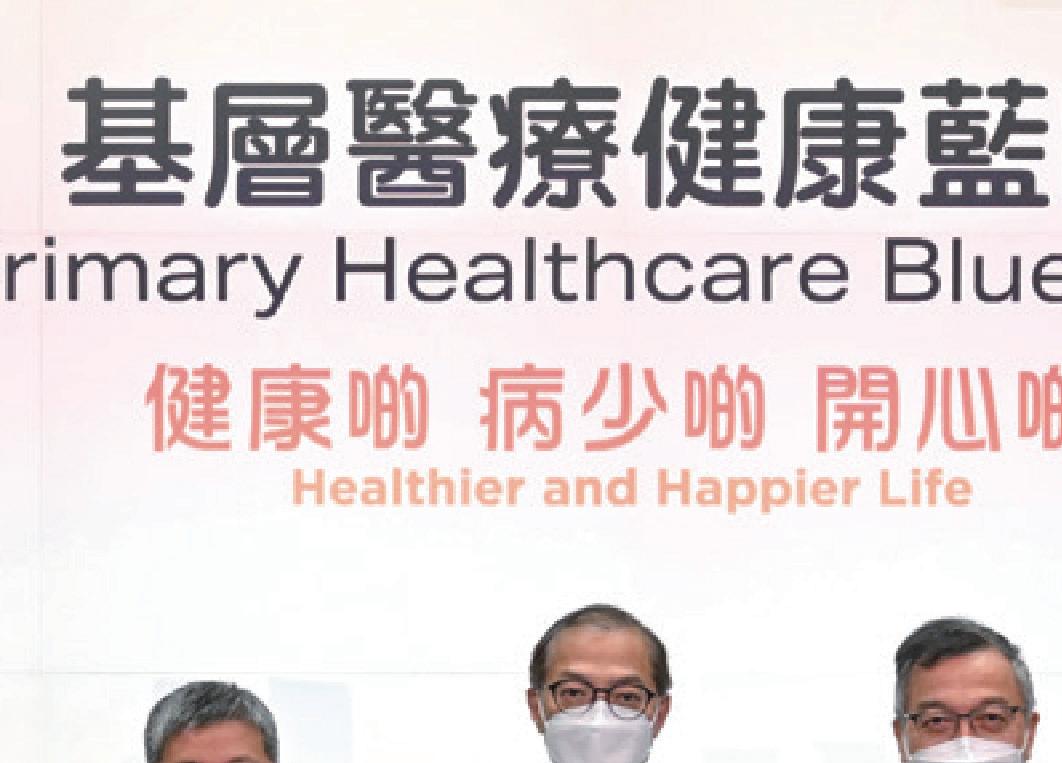

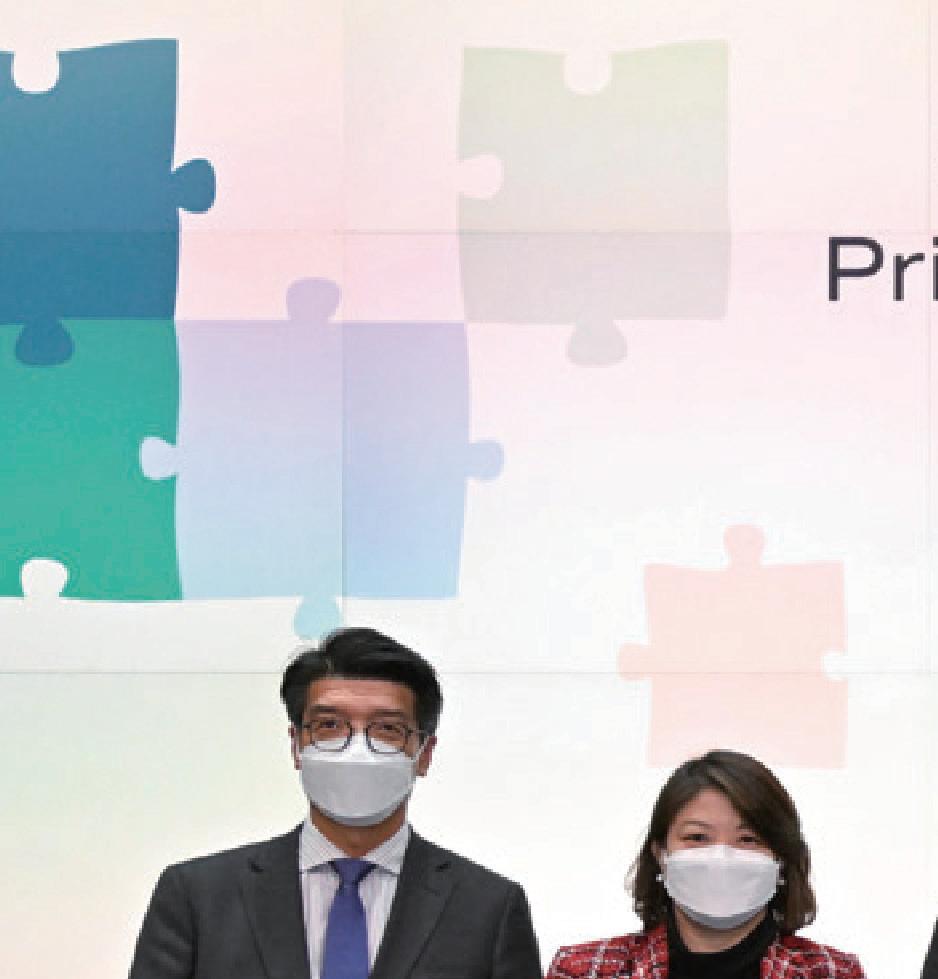

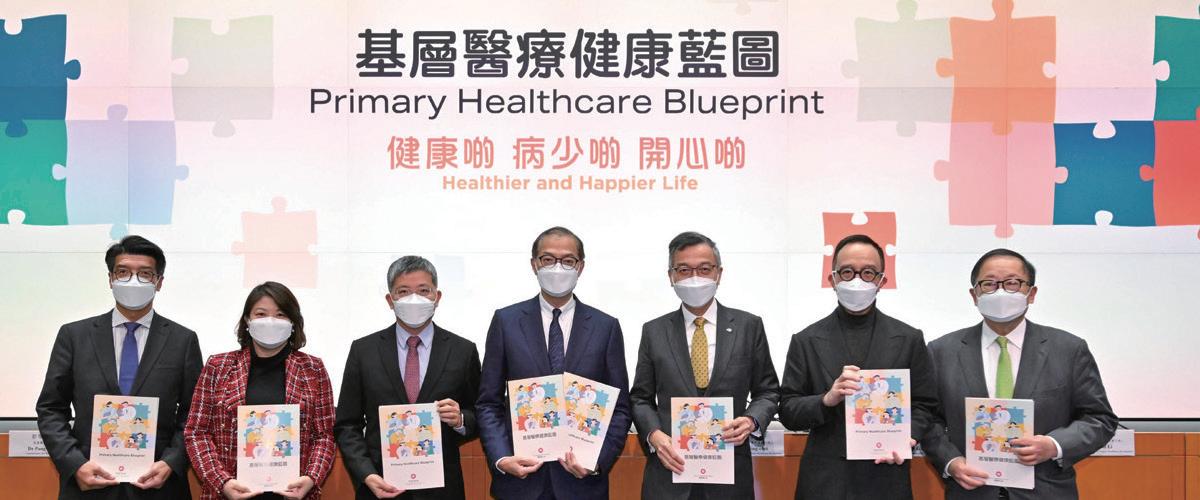
With the introduction of the CDCC Scheme, we see the need to reposition GOPCs progressively to enable a targeted use of public resources. As a safety net for the population, GOPC service should take priority care of the socially disadvantaged population groups (especially low-income families and the elderly poor).
The Government will continue to utilise information technology, digital technology and artificial intelligence infrastructures, with a view to providing members of the public with "Smart Healthcare" and enhancing operational efficiency. The Blueprint also proposes to transform eHealth from a basic health record sharing system into a comprehensive and integrated underpinning information infrastructure for healthcare data sharing, service delivery and process management. In primary healthcare-related services, it will facilitate service record keeping, essential data sharing (such as allergy histories, diagnoses, prescriptions, etc.), health monitoring and surveillance, case and workflow management (including triage, referrals and payments), and will explore the use of big data analytics to contribute to population health surveillance and individual health management.


HA Go is a very convenient and easy-to-use app that any citizen can install to use HA’s services. In particular, during the 5th wave of COVID, patients with infections could easily book and attend online consultations using HA Go on their smartphones without the trouble of actually going to a clinic. At the end of January 2023, nearly 200,000 online consultations had been conducted on the HA Go app by COVID Designated Clinics. With HA Go, online consultations are also being provided in phases by other Specialist Outpatient Clinics for suitable patients. HA Go will soon provide electronic sick leave and attendance certificates, and will also provide drug delivery services. This will greatly improve patients’ experience, especially for the elderly and those living in rural areas.
Since the Government launched the Primary Healthcare Blueprint in December 2022, I am very delighted that we have received overwhelming response and support from the community and the healthcare professionals. Primary healthcare is the first level of care in the healthcare system and is the first point of contact in a continuing healthcare process. The key concept of “prevention is better than cure” in primary healthcare should be imprinted early in the mind of our young people who should start managing maintenance of their health early rather than seeking treatment for their illnesses later in life. I encourage all young people to start health management with your friends and family today and to visit the DHC next to your residence or working place. With your support, let us join hand in hand to make sure that we can build a healthier Hong Kong.
have received overwhelming response and support from



8 Interview
Addressing Hong Kong’s Health Gap
Bymost health indices, Hong Kong ranks among the best in the world, in terms of registered live births, life expectancy and with the leading cause of death for both men and women related to malignant neoplasms.1 So what do we mean when we say that Hong Kong has a health gap? Dr Roger Chung from the Chinese University of Hong Kong explains.
• 香港的預期壽命全球最高,有時或會忽視引致健康不平等的 社會差異。


• 假如僅以二元對立的方式去審視醫護政策,而未有考慮社會 經濟因素,例如生活方式和行為因素、物質環境和市民的 心理健康狀況,這明顯是過猶不及。

• 我們的視野亦應放遠於醫護政策的背後,因為大部分市民 除非生病,否則不會進入醫療體系當中。

• 要改變這個模式,需要由教育方面入手,以及有關當局願意 聆聽的意願。

The Health Gap

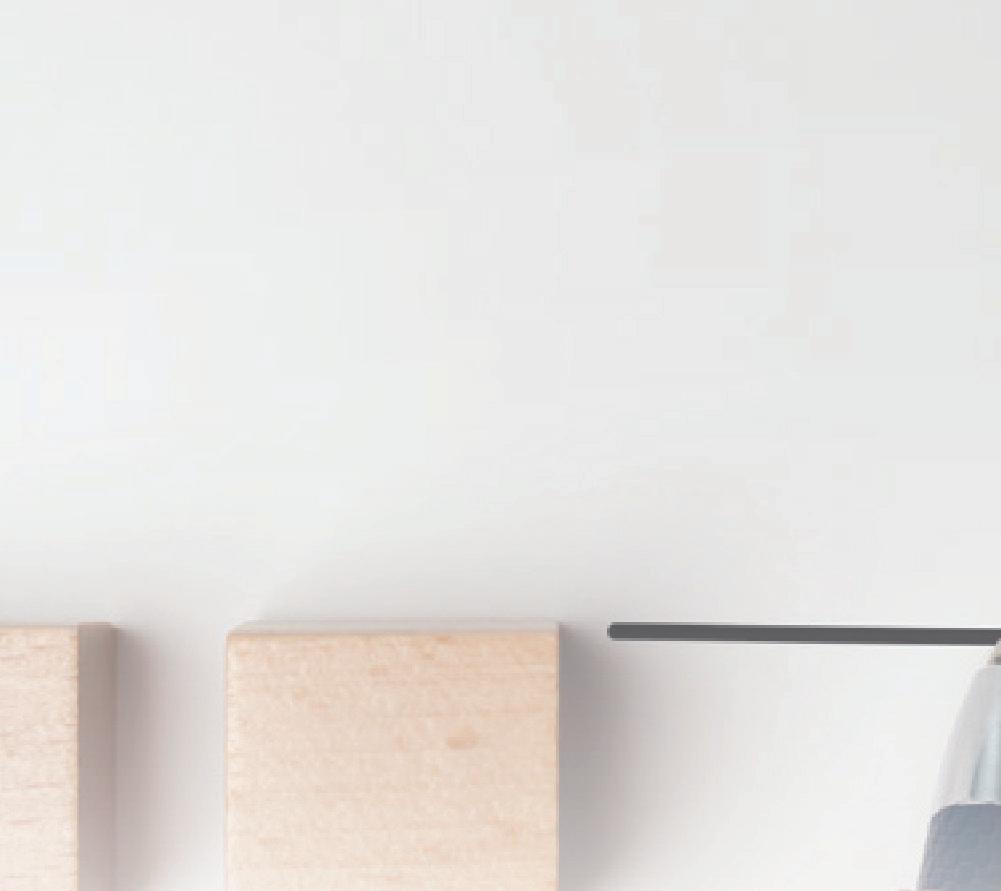
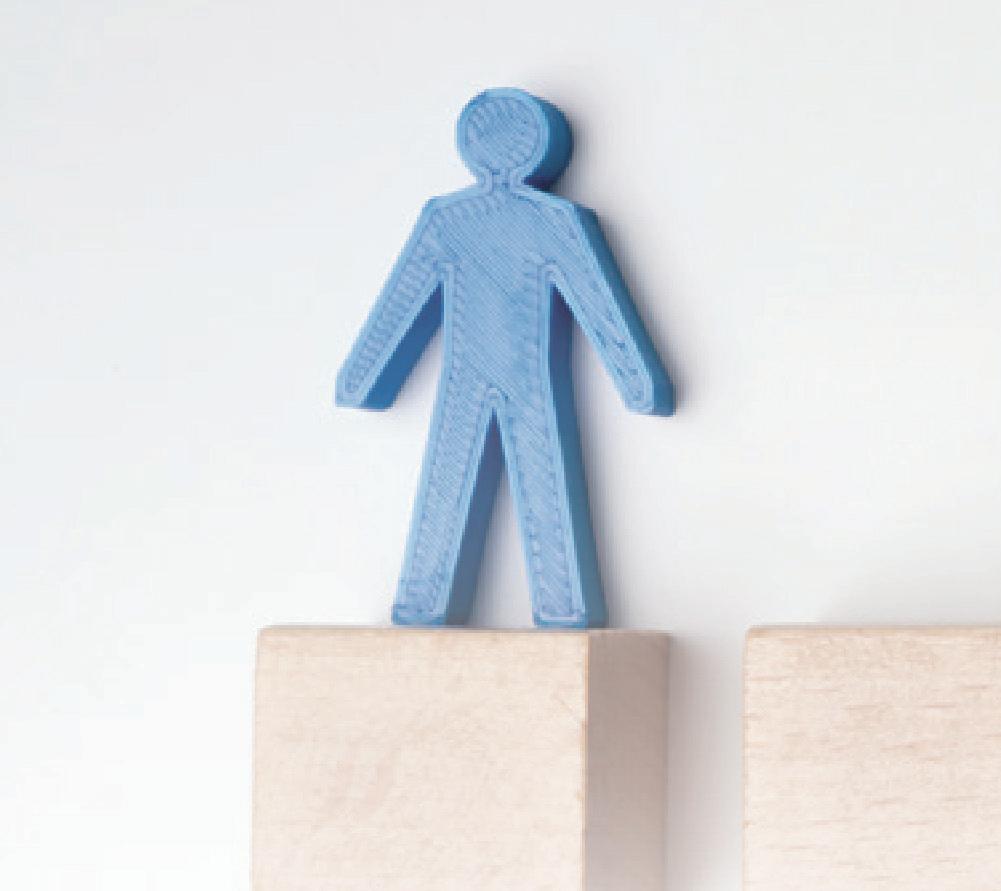
Historically, according to Dr Chung, Hong Kong has had a resilient population as immigrants from the Mainland and survivors of war and upheaval, many with the will and determination to survive and thrive. Given the more current and positive statistics of overall health, it could be easy, therefore, to overlook social disparities that have resulted in health inequalities.
These health inequalities, Dr Chung argues, are not necessarily the result of Hong Kong not providing available or accessible health care. Conversely, Hong Kong has a relatively well organised health care infrastructure, both public and private that – in the main – is both affordable and accessible for the vast majority of the population.
Where the disparities lie can be found if one looks at public health through the lens of a social gradient. According to The Health Gap, a Chinese version published in 2021 by the Chinese University of Hong Kong, Dr Chung referenced leading scholar Professor Sir Michael Marmot2 in explaining that “health inequalities should also address the inequalities in educational attainment, employment, income, and quality of the neighbourhood, among other determinants.” It was not enough to look at healthcare policies in a dichotomous way without taking into consideration socioeconomic determinants such as behavioural and lifestyle factors, materialistic circumstances and even the state of psycho-social health.
9
Dr Roger Chung, PhD, MHS
Achange of paradigm ... needs education and the willingness from the authorities to listen.
In fact, to help level the inequality in health care, Dr Chung continued, “Greater universal action is needed to reduce the steepness of the social gradient of health inequalities, which is proportionate to the level of disadvantage3. He did acknowledge that while there are intermediary determinants like lifestyle behaviours that everybody relates to in general, studies “would also reveal upstream factors related to culture and societal values. For example, what are the more upstream social factors that make people drink and smoke more while exercising less?” Similarly, “It would be unfair and inequitable to say, for instance, only those who are more well off should have greater access to healthcare. Many have this misunderstanding that the social determinants of health are just limited to healthcare policies, which they shouldn’t be.”
Instead, determining the state of health only by looking at healthcare policies, according to Dr Chung, “should be the last thing for consideration! We should see beyond healthcare policies because most people do not show up in a healthcare system unless they have fallen ill.” And even then, there is the question of those who are not currently able to show up for health care support, because perhaps they are daily wage earners or someone on shift work, or single parents who need to take care of their children at all times, or patients who are even deterred by geographical and logistical hurdles to seek proper treatment.
So what might be the solution to address and close this health gap?

Time for a Collaborative Approach





A strategic and holistic approach is needed according to Dr Chung, who recommends at the very least that health care policies require an interdepartmental approach among the various governmental bureaux, including labour, education, social welfare, housing and even equal opportunities. “A change of paradigm towards these issues needs education and the willingness from the authorities to listen.”
Beyond this, which he agrees is not an easy task, Dr Chung also argues for a more distinctive understanding of both ‘primary healthcare’ and ‘primary care’, which are two very different separate entities on their own. ‘Primary healthcare,’ which strives for universal health care accessible to all, is arguably not achieved in Hong Kong, since some people are inadvertently denied adequate health care due to lack of financial means as the outpatient clinics are mostly privatised and our public General Out-Patient Clinics (GOPC) are also scattered geographically.
For Hong Kong to do more than resemble the resilience of the early generation of migrants, it becomes necessary to establish a health care system based on equity, something that is contingent upon all stakeholders in the community to come together and build a fairer and sustainable society. This would, Dr Chung argued, require a reimagining and reanalysis of looking at health care simply from a resources allocation perspective, to something more akin to a capabilities approach, where consideration is paid to enabling people to have equal capability to translate these resources into actual health benefits.
Interview 10
Cannot look at health care policies in a dichotomous way without also considering socioeconomic determinants.
Based on Sir Michael Marmot's research, here are five recommendations drawn up by the CUHK Institute of Health Equity to reduce health inequalities in Hong Kong 3:
To raise public awareness of the importance of health inequalities, social gradients of health and social determinants of health.
The government should set up new databases that provide necessary linkages between socioeconomic indicators and health outcomes and improve existing collection of data to identify and monitor health inequalities in Hong Kong regularly. Where possible, the data should be disaggregated by age, gender, socioeconomic position, and geographical areas and include new indicators on vulnerable groups and the extent of healthy ageing in the society.
The government should work with other sectors, including academia, social care and healthcare, professional bodies, businesses, charities and voluntary organisations, in developing policies across the board to mitigate the social determinants of health inequalities and alleviate the burden of disease on disadvantaged groups.


To review the impact of COVID-19 and the containment measures on physical and mental health of different social groups, including school children, working adults and foreign domestic workers. To incorporate analysis of the impact of policies on health equity of society in future policies and measures to tackle the pandemic.
In the long run, it is necessary to establish a unified vision on fair and equitable society in Hong Kong through engaging and building up consensus with stakeholders in different sectors including the government and the civil society. This initiative should be placed in the larger context of the UN sustainable development goals and the WHO’s decade of healthy ageing.
Dr Roger Chung, PhD, MHS, is currently an Associate Professor of the School of Public Health and Primary Care (SPHPC) of the Chinese University of Hong Kong (CUHK). He is also the Co-Director of the CUHK Centre for Bioethics and the Associate Director of the CUHK Institute of Health Equity.
References:




1. In 2021, the crude birth rate was 5.2 registered live births per 1,000 population, while life expectancy at birth for male and female were 83.2 and 87.9 years old respectively. For these and more statistics, see: https://www.healthyhk.gov.hk/phisweb/en/chart_detail/12/
2. https://www.thelancet.com/journals/lanwpc/article/PIIS2666-6065(22)00251-6/fulltext
3. https://www.ihe.cuhk.edu.hk/wp-content/uploads/Health-Equity-Report-01.pdf
11
RECOMMENDATION 2 RECOMMENDATION 3 RECOMMENDATION 1 RECOMMENDATION 4 RECOMMENDATION 5
In the Search for Healthy and Balanced Lifestyles


Youngpeople's lifestyles play an important role in the development of vulnerability and health in later life. Youth Hong Kong gathers feedback from different groups of youth.
• Four young professionals share their beliefs and mindsets about trying to strike a work-life balance in Hong Kong.
• 30 youth from the HKFYG Lee Shau Kee College also share insights on how their lifestyles affect their personal development and health.
• 在現今競爭激烈的香港社會,四位年輕專業人士分享他們 積極實現工作與生活平衡的信念和心態。
• 另外,30名來自香港青年協會李兆基書院的青年亦分享 他們各自不同的生活方式,如何影響他們的個人發展和身心 健康。
22-year-old Gladys Wong leads a hectic lifestyle like most Hong Kong youth, while pursuing her Professional Certificate in Laws (PCLL) at the same time. Very often, she has to work late into the night and often on weekends on tasks as assigned by her senior colleagues. Staying up till 4 or 5 am while working on IPOs and then returning to work at 9 am the next day for instance is common for her peers and her working in the law industry. The lack of work-life balance for entry-level professionals like her often leads to poor eating habits due to the heavy workload and high-stress levels. She shares, “I know of some friends who even develop eating disorders and anorexia due to stress from work. They devote 80% of their time to work, and they do not have enough time to destress, exercise and spend time with family and friends. This is detrimental to both physical and mental health.”

Other than eating regularly, the other challenges also extend to time and budget. Young professionals like herself are always busy due to their heavy workload and they may not have time to prepare nutritional meals with the right proportion of vegetables, carbohydrates and protein. Often, ordering takeaways also lack substantial fibre and in turn, are high in fats and sodium levels. The healthier options to have salads and fruit bowls are a good substitute but not sustainable in the long run, which can also be more expensive than the usual takeaways.
Nonetheless, Gladys is aware that having enough sleep, mindful eating and exercising are important. Being aware of the emotional state of mind also helps her to better cope and defray negative emotions. Gladys relies on health-related apps to keep track of her body and mental health records. The reminders, tips and suggestions make it easier for her to rely on while she is still occupied at work. Gladys also hopes the entire ecosystem in the public and private sectors would evolve gradually to ensure healthier lifestyles for entry-level professionals like her. It could lead to a brain drain eventually, as more choose to migrate to other countries for a less stressful pace in life.
Seeing eating disorders happening to some of her peers is a clear sign to Gladys that self-care is becoming more and more important in this day and age. Gladys strongly believes having a healthy body image and a positive mindset are correlated, and the way to go in the long run.
12 Youth Speak
A healthy body image and a positive mindset go hand in hand
30-year-old Keith Leung who works as a Senior Vice President in a local bank likens leading a healthy lifestyle to maintaining a car in top form that needs the right type of fuel; ample rest, regular maintenance, and grooming in order for it to go on for miles. The only difference between humans and vehicles is the additional need to develop a mental state of health, such as social time with friends or “me time”.
Keith elaborates more, “We often over-prioritise the short-term rewards while undermining the long-term damages from poor lifestyle habits. It could be staying up late to finish an online video streaming series while not having enough sleep. It could be suppressing our feelings to avoid conflicts while suffering in silence. It could be social media overconsumption while procrastinating the completion of more important tasks. It could also be setting up new year resolutions that are not workable or not being able to keep to it due to other activities in life.”
Keith however believes keeping physically and mentally healthy can actually be “infectious” in turn. “As social animals, our norms are shaped by our culture which develops and thrives in communal settings such as living in familial clusters or working in teams.” Similarly, having like-minded family members and friends who enjoy working out and keeping to a healthy lifestyle together sparks a meaningful motivation to forge stronger bonds and camaraderie with one another in managing the stresses in life in general.
Engage in meaningful activities





















21-year-old undergrad Nathan Cheng believes Hong Kongers are generally healthy physically and well supported by a robust and dedicated public healthcare system but support for mental health well-being needs more attention.


“I often take part in sports, social interactions, skill development, and other everyday activities. But unforeseen factors or circumstances, such as an epidemic, terrible weather, or additional schoolwork from varsity can frequently make me feel down. While services are well provided through the public healthcare system in Hong Kong, counselling services much in need for mental well-being are often pricey and unaffordable from private therapy clinics. I read motivational books as an alternative to recalibrating and rebalancing my mental health,” Nathan explains.
Nathan tries to further improve his state of mental well-being by engaging in enjoyable and meaningful activities. These include taking a six-month course to develop new skills; sticking to a better sleep routine and maintaining a regular exercise regimen.
Nathan is however mindful that the turbulent state of mind and the discipline to keep to a healthy body image could sometimes result from cognitive and behavioural dissonances when an individual's behaviour is inconsistent with his or her thoughts and beliefs. “Most smokers, for example, are aware of the detrimental effects of smoking but make the excuse that it does not cause physical sickness, and there are others who continue smoking nonetheless. Everyone understands that regular exercise is beneficial to both physical and mental health, yet not everyone does it.”
Nathan firmly believes Hong Kong needs to move beyond economic and materialistic success in order for it to evolve as a full-fledged holistic society. Shifting focus on mental health would propel Hong Kong to become a city with better quality of living on all fronts.
13
Eat more greens for anti-inflammation and better immunity
25-year-old start-up co-founder Vivian Lai switches to a “green” diet sometimes as a means of managing stress, other than keeping to regular exercise and getting sufficient sleep. Vivian shares candidly that keeping to greens is not necessarily about becoming a full-fledged vegetarian. “I just choose meals that are more plant-based and rich in antioxidants and nutrients. This in turn helps to reduce inflammation and boost my immune system. I become more energetic when I choose more green meals for lunch at work!”

Vivian adds that it is important to find ways and activities to promote emotional and psychological well-being, such as forming positive social connections; participating in regular practices, other than developing personal hobbies and interests. In Vivian’s perspective, mental health, emotional well-being and physical are multi-dimensional. Even seeking professional help when necessary is essential.
Vivian also feels many factors could attribute to the challenges of striking more balance for physical and mental health well-being for Hong Kongers in general. Deprivation of sleep is common among Hong Kong youth. Being a densely populated metropolis can also lead to claustrophobic fears and stress. Vivian emphasises the need of making time for self-care, such as going for yoga, meditation, a relaxing bath or even making a hand-drip coffee when she’s packed to the brim for work.
Vivian hopes that the promotion of public health and the provision of access to quality healthcare services should remain the top priority for governments, non-profit organisations, and other stakeholders in the making of a healthy society. Having a better quality of life promotes productivity, reduces healthcare costs, and strengthens communities as a whole.
What Makes Youth Tick?

YHK did a qualitative analysis with 30 youth from the HKFYG Lee Shau Kee College on their views on their current lifestyles. Here are some interesting revelations:
Gaming gives me a lot of satisfaction as I can be someone else in the game. I find it easier to make friends when it is not face-to-face like in the real world. I don’t feel judged based on my looks. I can also chat with other gamers easily. Playing and winning online feel great!
Iam happy with my parents and friends because they are nice to me. I don’t feel so lonely when they are supportive of my decisions in my studies and lifestyle or provide a listening ear when we take a break from school.
I still get to enjoy my life even though school is stressful and my grades are not up to mark sometimes. I tell myself to keep doing my best. In my free time, I will play basketball or hang out with my friends to manage my stress better.
14 Youth Speak
Type of sports: mostly ball games such as badminton, basketball, volleyball

More sleep will be ideal!
Most of the youth surveyed responded with the following as their favourite food:

































Junk foods such as hamburgers and chips
Sweet foods such as candies and ice cream
Healthy foods such as fruits, vegetables, and carbohydrates

The understanding of “healthy” and balanced dietary preferences is debatable, even though they are considering themselves to be eating well.
The duration of exercise is relatively sufficient for a duration of 30 minutes or more.
1st
2nd 3rd
15
Heavy school workload is seen to be interfering with their leisure time.




Sleeping late and leisure time override exercise time.
Youth surveyed attribute their happiness to the company of friends, family, and social gatherings. Grades and academic stress often make them unhappy.
16 Youth Speak
Efforts on Sodium and Sugar Intake Prevention







Asreported by the World Health Organisation (WHO), non-communicable diseases (NCDs) kill 41 million people each year, which is equivalent to 71% of all deaths globally1. 20% of most deaths are attributed to food-related causes, where the dietary preferences include foods with excessive salt and sugar levels. How is Hong Kong tackling this growing health focus?

Excessive dietary sodium and sugar intakes are closely related to health, and in particular, the association with non-communicable diseases (NCDs) such as hypertension, cardiovascular diseases, strokes, and coronary heart attacks, while excessive consumption of sugar increases the risk of obesity, diabetes, tooth decay as well as cardiometabolic risk.


In Hong Kong, people aged 15 to 84 years old usually consume 8.8 grams of salt daily, which is slightly higher than the recommended level for adults by the World Health Organisation (5 grams of salt or slightly less than one level teaspoon of salt). The mean daily intake of total sugar among local adults was 53 grams per day, slightly higher than the WHO’S recommended level of 50 grams daily2.



Current Chairman of the Committee on Reduction of Salt and Sugar in Food (“CRSS”) Mr Cheung Leong explained that these are the reasons that the CRSS was set up in March 2015 to advise the Secretary for Food and Health on the formulation of policy directions and





work plans related to the reduction on the intake of salt and sugar by the public. Collectively, they hope their efforts will help to encourage behavioural change, and instilling prevention and the control of NCDs in the city by the year 2025. Much has been done to date.
1) the Salt Reduction Scheme for School Lunches to reduce the average sodium level of primary school lunches to not more than 500 milligrams. 13 lunch suppliers participated in the Scheme with sodium-reduced lunch options for 80% of all primary schools in Hong Kong.
2) the “Healthy Drinks at School” Charter to reduce the intake of excessive sugar from drinks for preschool students. About 45% of all kindergartens and childcare centres had participated in this programme.
3) the Less-salt-and-sugar Restaurants Scheme encourages restaurants to provide customers with food options of reduced salt and/or sugar or tailor-made less-salt-andsugar dishes. Some 1,100 restaurants have come on board.

17
Special Focus
4) the "Salt/Sugar" Label Scheme for Prepackaged Food Products to help consumers easily identify prepackaged food products that meet the legal definitions of "low salt", "no salt", "low sugar" and/or "no sugar" by label display. So far, over 240 prepackaged food products have participated in the Scheme.


5) large-scale publicity events, sponsoring radio and television programmes, promoting low-salt-low-sugar diet through posts on social media, and performing online cooking demonstrations with less salt and sugar.
Mr Cheung went on to add that the life expectancy in Hong Kong is one of the longest in the world. With early preventive measures among the youth; advocacy of behavioural change and taking salt and sugar in moderation, aging citizens can live healthier lives even in their twilight years.
He further emphasised that children who grow up eating lesser sodium and sugar intakes will actually develop healthy eating habits. He also cited examples of young budding cooking talents on social media as a growing trend.
“I think it is difficult to ‘preach’ or restrict youth from eating anything, especially when they are in their teens. I have two children aged 16 and 18 years old, and we sometimes indulge in ice cream when we feel like having it. But for every household, there will
come a phase where you will miss the family cooking. So the taste that you grew up with will somehow shape and develop your tastebuds. If you grow up in a household where healthier options are offered during family meal times, the preference for healthier meals will continue to be in personal dietary preferences.”
In the remaining year of his three-year term at CRSS, Mr Cheung hopes to finalise the collection of more precise data analytics on the eating habits of Hong Kongers. About 11 rounds of surveys have been conducted to understand various demographics such as age groups; income groups, knowledge, and behavioural attitudes of Hong Kongers’ consumption on salt and sugar levels. From the data, CRSS hopes to dive deeper into consumers’ health gaps and forge better collaborations with industry players to more preventive measures to greater success.

Cheung Leong
Chairman of the Committee on Reduction of Salt and Sugar in Food (CRSS)
References:


1. https://www.who.int/news-room/fact-sheets/detail/noncommunicable-diseases



2. https://www.legco.gov.hk/research-publications/english/essentials-2022ise03-measures-to-reducedietary-sodium-and-sugar.htm#:~:text=CRSS%20was%20set%20up%20in,academia%20and%20 the%20education%20sector.
3. https://www.legco.gov.hk/research-publications/english/essentials-2022ise03-measures-to-reducedietary-sodium-and-sugar.htm#:~:text=CRSS%20was%20set%20up%20in,academia%20and%20 the%20education%20sector.

4. https://www.scmp.com/news/hong-kong/article/1736947/bernard-chan-lead-committee-reducingsalt-sugar-hongkongers-diets










5. https://www.gov.uk/government/publications/restricting-promotions-of-products-high-in-fat-sugar-orsalt-by-location-and-by-volume-price/restricting-promotions-of-products-high-in-fat-sugar-or-salt-bylocation-and-by-volume-price-implementation-guidance

Special Focus
18
Recreating Healthier Options for French Cuisine





William Hung is fully aware that his birth city is globally reputed for being a top-notch culinary hub with many wonderful restaurants renowned for its delicacy offerings. For all the great food he has been fed since young, he is fully aware that many of these tantalising dishes like roasted barbecued pork (char siu) and shrimp dumplings (har gow) are also high in sodium and sugar levels. It was during his time in UK for further education that he realised healthier food options can be equally delicious and moderately seasoned. “The concept of low sodium and low sugar has already been embedded in young children and teenagers in UK. In their curriculum, there are also lessons taught about the risks of having high sodium and high sugar diets. So the dining habits are already quite ingrained in UK citizens’ lives.”
Having formally worked with a reputable food condiment player, and now, online food platform since returning to Hong Kong, William notices trends are shifting in Hong Kong. Consumers will now opt for healthier options such as lesser sugar when ordering a takeout such as a Cantonese dessert or blanched vegetables with lesser oyster sauce.









William shares his personal preference of French cuisine. It was a great opportunity that he could attend classes at the famed cooking school, Le Cordon Bleu while studying in the UK. The essence of French cuisine cooking, where mains use better, he now tries to replace with other lesser sodium substitutes. For French desserts such as poached pears in wine, William tries to lower the sugar content while retaining the taste. William concludes that he also wishes his family and friends will get to enjoy his cooking while not having to forsake their health at the expense of gourmet dining.
 William Hung
William Hung
19
Member of the Committee on Reduction of Salt and Sugar in Food (CRSS)
Education Begins at Home


It was the love and prolonged consumption of delicacies like dried Chinese sausages ( lap cheong ), dried salted fish ( haam yu ) and other processed foods that are high in sodium and sugar levels that caused Christa Cheung’s parents to develop diabetes. Christa is determined to change it around for her and her own household after this unfortunate event. Other than her full-time employment as a social worker at the HKFYG, Christa starts exploring cooking local dishes more healthily.


From her sharings on social media, Christa is often invited to local radio and television programmes to share more about her improvised recipes targeted at younger people and the elderly. Christa’s sole belief in public education and raising awareness is to advocate behavioural change, which explains why she spends time experimenting with the replacement of using condiments with fresh whole ingredients instead. Her improvised vegetarian radish cake instead of the traditional recipe using lap cheong and dried cured ham (fo teoi) was among some of the popular delicacies that are hits on social media!
Member of the Committee on Reduction of Salt and Sugar in Food (CRSS)














Being a full-time working professional and mother to a newborn baby is never easy, Christa adds. Most of the daily cooking has to be delegated to her foreign domestic helper. She has been writing down recipes to share on social media and also teaching her helper how to make proper seasonings instead of relying on ready-made processed foods. Making chicken soup from scratch and going to the wet market for fresh wholesome ingredients have become invaluable educational sessions for her to share with her helper. Christa hopes her helper will also become another convert like her to living and eating more healthily.
 Christa Cheung
Christa Cheung
20 Special Focus
From “ I Am” to “ We Are”
YouthHong Kong interviews the Federation’s Deputy Executive Director, Ms Hsu Siuman to find out how the organisation has kept up to current times.
Keeping up with young people’s interests, concerns and passion is how the Federation remains relevant and develops resilience in them. The purpose of offering a wide range of services from counselling to leadership development; entrepreneurial exposure to educational opportunities; thematic programmes from leisure, culture, sports, and arts to multimedia community projects are some of the tactics devised to enable Hong Kong youth to perform well academically, forge deep relationships and remain optimistic about their future, despite of adversaries.
It is through this partial self-help, partial self-discovery journey that the Federation hopes to instil in the young people, that they are first to be engaged as users/members, then participating as volunteers to offer assistance to others, before progressing as youth leaders.

Ms Hsu explains, “Our aim is to instil self-confidence in themselves by first joining community activities activities organised at our various Youth S.P.O.Ts. By stepping out of their comfort zone, we see a mindset shift from ‘I am’ to ‘We are’.
ABC Wellness Model
On a deeper level, Ms Hsu shares the “ABC Wellness Model” concept: Awareness of personal health needs; living a Balanced life, and Connection through meaningful relationships, so that young people can build a more “All-Round Wellness” approach in life. This was derived from a 2021
report published by the Federation1 (「全


報告 ) advocating the development of all-round wellness.
1099 respondents aged 12 to 34 were interviewed on their understanding of overall health and the impact of the current social environment on health, where 64.1 % of the interviewed youth confessed never having heard of the concept of “holistic health". The average score for the level of concern on general health was a mere 5.97 points, which was slightly higher than the national median level of 5 points on a scale of 0 (not concerned at all) to 10 (very concerned).
The Federation further proposes to help young people develop in more balanced ways from six areas in life, including Physical Wellness ( 身 ), Emotional Wellness ( 心 ), Social Wellness ( 社 ), Occupational ( 職 ), Digital Wellness ( 數 ), and Environmental Wellness ( 環 ). Wellness (社 ), Occupational (職 ), Digital Wellness (數 ), and Environmental Wellness (環 ).
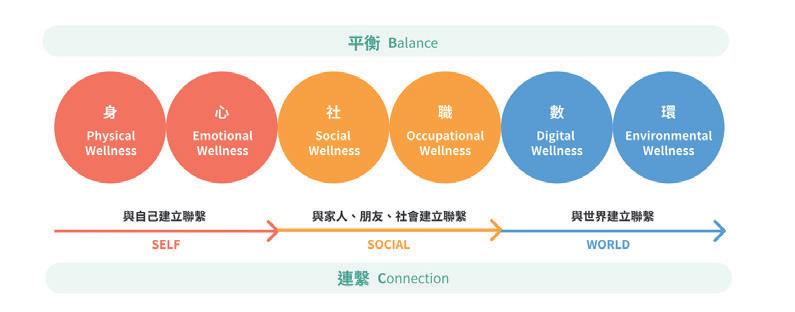
The evolvement of these studies conducted by the Federation is not new. In fact, the Federation holds yearly surveys as part of the “Care Hotline 2777 8899” initiative2, where the statistics collected give good insights into high school students’ emotional state of health
The scope of data collection and analyses include a better understanding of their stress level

人健康 連繫內外」
覺察 Awareness 連繫 Connection 平衡 Balance 全健 ABC 21 Professionals' Speak
The evolvement of these studies conducted by the Federation is not new. In fact, the Federation holds yearly surveys as part of the “Youthline 2777 8899” initiative2, where the statistics collected give good insights into high school students’ emotional state of health. The scope of data collection and analyses include a better understanding of their stress level index; determinants of their stress levels; as well as how well the young people are seeking professional help to help themselves. This resonates with other field studies where it is often found that individual, family and environmental risk and protective factors do affect young people’s development and resilience.

Ms Hsu also extends the nurturing of resilience to the mental well-being of individuals, other than the physical state. Being able to “bounce back” from difficulties or challenges, and then move forward can be equally edifying moments.
The establishment of #wholewellness ( 「全健空 間」 ) is one such initiative where professional courses and activities related to healing, self-awareness, and new experiences are organised. As a digital extension, an online wellness platform called #wholewellness is catered to young people. Dedicated hashtags on Instagram such as “#Wellness 111” are introduced to encourage young people in committing to at least one healthy exercise every week, while "#Healing Tuesday” promotes the need for self-care once a week.

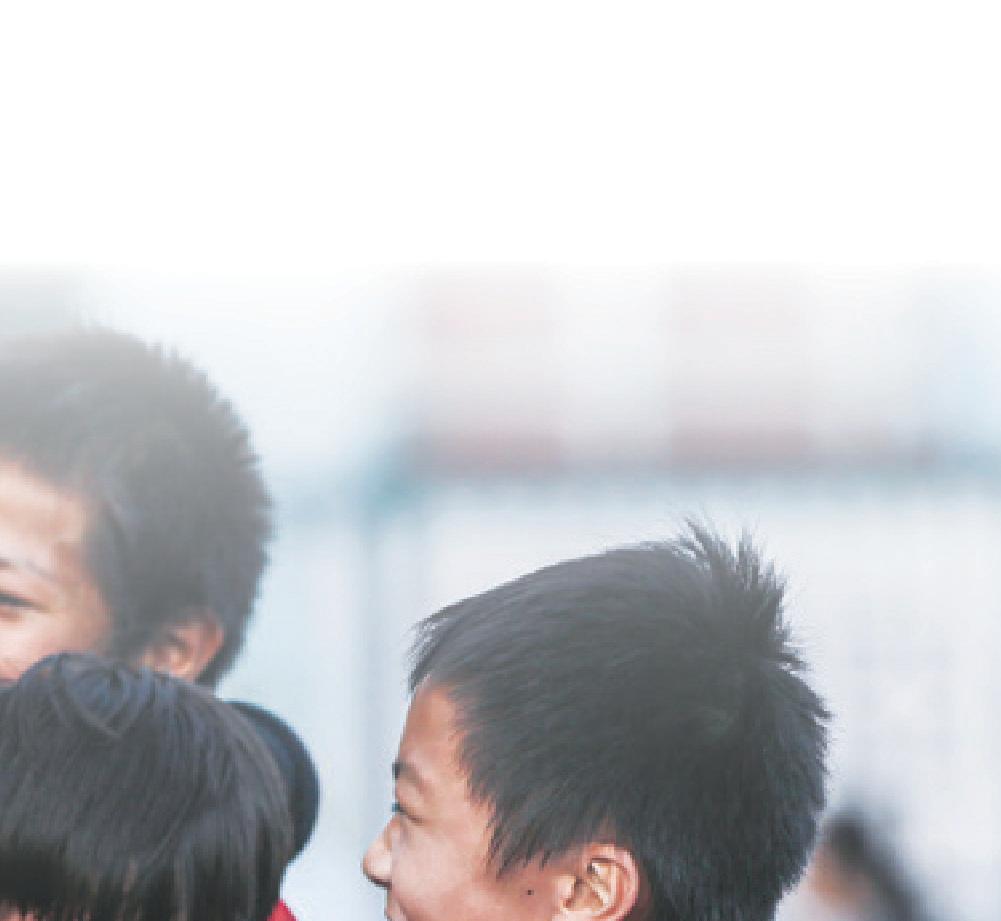
Many of our participants started off as members, and they have feedbacked positively of being able to effectively manage stress in one situation, making them better able to cope with stress and challenges in future situations.
References:
1. https://hkfyg.org.hk/zh/2021/07/07/wellness_report/
2. 青協「關心一線 2777 8899」公布「中學生情緒及求助狀況」調查結果
Such mental health promotion strategies encourage cultural sensitivity and awareness, together with respect for one another’s differences, regardless of age, gender, sexual orientation, culture, socio-economic situation or abilities.


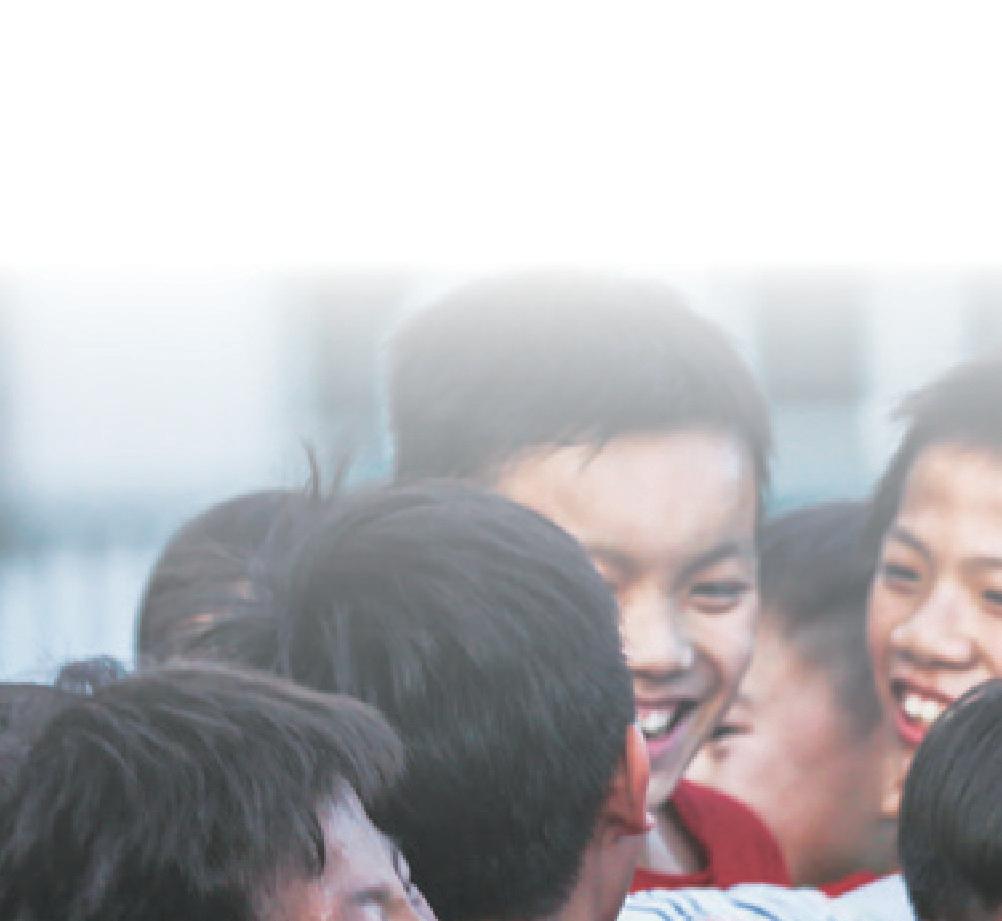
Other successful and ongoing significant projects organised by the Federation would be its successful thematic programmes where core values related to resilience such as care and inclusiveness are reinforced. The well-received Neighbourhood First Reunion Lunch has been held during every Lunar New Year since 2012, with a hiatus during the COVID-19 pandemic (2020-2022). The event often garners about 1,000 tables, which is well-attended by a strong turnout of 12,000 young people, neighbours and the community of different districts collectively coming together for a good feast of traditional delicacies.
“What we have done in the Federation so far has come a full circle. Many of our participants started off as members, and they have feedbacked positively of being able to effectively manage stress in one situation, making them better able to cope with stress and challenges in future situations. Rather than merely bouncing back, dealing with challenges make them grow and become stronger. They also tend to be empathic, and many of these youth become good communicators and effective problem solvers. This explains their eagerness to keep serving in our programmes relentlessly,” Ms Hsu concludes.
Hsu Siu-man is currently the Deputy Executive Director of the Federation and has rich experience in youth counselling service. She is now responsible for the strategic corporate planning and communication, partnership and publication, and the Federation’s education, counselling and new services development.

22 Professionals' Speak
Building up Resilience and Beating Stress
Oft times it is the small steps and tweaks we make in our lives that can have the greatest impact. In sharing his tips on how to deal with everyday pressures and alleviate stress, the Federation’s clinical psychologist, Ernest Wong, encouraged us to re-think some very basic actions:
Sleep
With so many distractions and deadlines, along with an increasing work load, it is easy for stress to build up and not getting enough sleep and rest, simply adds to the anxiety. Sleep is essential for our overall physical and mental health. It helps with repair, rejuvenation and memory consolidation. Instead of staying up all night to study, make sure you get enough sleep to allow for memories to “sink in”.
Physical Activity

We all know how easy it is to be sedentary and we also all know that getting enough exercise helps with weight management and reducing the risk of disease by strengthening bones and muscles. But being physical also helps with improved moods as the body releases chemicals like endorphins and serotonins that help us to cope with stress and even depression. Exercising regularly also helps improve our sleep.
Eating Well
When stressed, it is easy to skip meals or binge on comfort – many times, junk – food. Eating well balanced, nutrient rich food helps control mood swings and improves our ability to focus. Regular, well-balanced meals with less sugar and less salt can be simple ways that improve general wellbeing.

Staying Consistent Supportive Network













“Repetition is the mother of transformation” as the saying goes. What this means is that sticking to a regular routine can lead to a greater sense of accomplishment and even ego gratification which then makes one feel more positive and optimistic, further leading us to making more constructive and affirmative choices.

Being stressed can be a lonely place to be. It is so important to have a safe and supportive network of family or peers around you. The benefits include our ability to cope with challenging situations, as well as alleviating emotional distress, by sharing our difficulties and leaning on others. Mutuality helps promotes connection, inspires hope and teaches us better coping skills.
While all these small actions do seem obvious, they are not always things we do in a mindful way. When we prioritise our sleep, exercise, eating, routine and networks, we are far better placed to deal with not only the minor stresses and irritations of daily life, but are also able to build a good foundation when things really do get tough.
Ernest Wong obtained a Bachelor’s degree in Psychology and Criminology & Socio-legal studies at the University of Toronto, a Master’s degree in Psychology at the City University of Hong Kong, and a Master of Clinical Psychology at the University of Hong Kong. He is currently a Clinical Psychologist at The Hong Kong Federation of Youth Groups.

23
“I became associated with the HKFYG in 2017 when I attended the “Hong Kong 200” professional leadership training programme. I was then only a secondary school student leader with a dream to generate social impact and make influence positively. From the programme, I learnt about the design thinking model seen with a social entrepreneurship mindset. I treasure the deep storytelling sharings of the local culture and traditional stories as I am a true-blue Hong Konger, born and bred in this city. It gave me the impetus to launch my first social project, Market for Hong Kong which aims to promote traditional market culture and the city’s “lion rock spirit”. I went on to start a social enterprise, City’s Treasure in 2019 to connect local shops, society and life in general in Hong Kong. I am thankful to everyone at the Federation who taught me the importance of becoming a passionate leader with empathy for society by devising creative solutions constantly.”
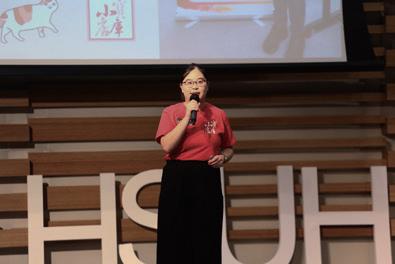


“ Throughout my entrepreneurship journey, I have faced a lot of ups and downs especially because I have to manage different roles as a start-up and a student/employee. But solving problems is the most enjoyable part of being an entrepreneur that all difficulties help me become a more resilient leader.”
Becoming a Resilient Leader Journey of Self-discovery

“I am always grateful to be given the opportunity by the Federation to participate in the "Youth Spot" magazine production during my varsity days five years ago. It was a remarkable self-discovering journey to be driven in scouring for feasible interview topics with other fellow young people as part of the production team. Even though the popularity of printed assets such as books and magazines is waning, I still love such printed materials as it forms an identity and archive of our city and its people.”
“This self-discovery journey has enabled me to better understand myself, especially with the awareness of my emotional needs. As I get to meet different people from all walks of life, I recognise there are different coping methods in relation to different emotions and challenges in life. I have learnt how to work on myself especially with my own mental health.”







“With the fast pace working in the news industry, I get to learn how to live with the pressure and recognise there are different coping methods in relation to different emotions and challenges in life. As I get to meet different people from all walks of life, it inspires me that there will always be a way out for my obstacles.”
– Jojo Chan, news producer currently.






Professionals' Speak
– Vanessa Cheung, Management Trainee at A. S. Watson Industries - Watsons Water.
24
Tele-medicine as the “New Normal”


Tele-medicine can help address disparities on the access to healthcare services in Hong Kong. A few factors remain particularly challenging for different groups of residents. Tapping on the younger people’s tech savviness may offer greater success.
A surge for tele-medicine has seen unprecedented demand at the start of the COVID-19 outbreak. In-person consultations are beginning to replace primary healthcare services in the face of social-distancing measures in many countries. Tele-medicine further offers greater ease of convenience and reduced risk of infections during the pandemic.
Tele-medicine is not new in medical diagnosis, and traces of tele-medicine records were already invented as far back as the early 20th century. A Dutch physiologist, Willem Einthoven developed the first electrocardiograph in Leiden, where he recorded patients’ electrical cardiac signals or better known as electrocardiograms (ECG) in today’s understanding. Eithoven was even awarded the Nobel Prize in Physiology or Medicine for inventing the first practical electrocardiographical system in 1924.
Renowned medical journal The Lancet also reported the usage of tele-medicine delivery in 1879, where a physician was archived as using the telephone to listen to coughs and ruling out a common respiratory disease among children.
Tele-medicine also forms an important area of global study and strategy in the World Health Organisation’s (WHO) Digital Health framework. The strategy in particular divides digital health solutions for member states to achieve universal healthcare coverage for the following categories: census information data warehousing, data interchange and interoperability,
emergency response systems, laboratory and diagnostics information systems, pharmacy information systems, public health, and disease surveillance systems, and tele-medicine.
Subsequently, the speedy transmission of data made video consultations increasingly feasible in real time. COVID-19 served as the catalyst for the exponential expansion of tele-medicine, but what will become of tele-medicine in the post-pandemic era?
Benefits and Shortcomings of Tele-medicine

The advantages of tele-medicine are extensive. Tele-medicine offers enormous potential for reducing the variability of diagnoses as well as improving clinical management and the delivery of healthcare services worldwide by enhancing access, quality, efficiency, and cost-effectiveness.
Decreased logistical delays and easy-to-use platforms for patients increase their accessibility to healthcare services. Diabetic patients can now update doctors on their self-monitored blood sugar levels on an app interface. Concurrently, doctors can provide advice and prescribe medications anytime, anywhere. Notably, tele-medicine will be particularly advantageous for groups challenged by limited mobility, such as the elderly, the chronically ill, and those living in more remote areas.
Gwen Sin
Special Focus 25
In Hong Kong, the development of tele-health services has been slow until recently in light of the easy and high accessibility to in-person healthcare services in the public and private sectors. While the usage of tele-health services has picked up after the outbreak of the COVID-19 pandemic, the sustainable development of tele-health services is dependent on the support of the Government and widespread adoption by healthcare service providers, and also the patients themselves.
The tele-medicine adoption rate was extremely low before the COVID-19 pandemic. According to a 2019 J.D. Power Pulse Survey tracking tele-medicine user experiences, only 9.6% of Americans used tele-medicine services in 2018, while 74.3% said they either has no access or were unaware of tele-medicine options.
In Europe, tele-medicine has largely failed to attract patients to change their consultation habits. The reasons include the unfavourable development of the regulatory environment, gaps between the healthcare system and insurance regulations, plus stricter privacy laws. In the UK, before the outbreak of COVID-19, video appointments made up only one percent of the 340 million annual visits to primary care doctors and nurses in Britain’s National Health Service.
Tele-medicine Observations in the Greater Bay Area
China’s tele-medicine services seem to have moved forward considerably. For example, Ping An Insurance’s ‘Ping An Good Doctor’ service recorded more than 300 million registered users before the COVID-19 outbreak. Internet mogul, Tencent, has invested heavily in its online medical platform ‘WeDoctor’, which allows patients to connect to more than 240,000 doctors online. In addition, e-commerce leader Alibaba also provides services such as tele-medicine and online drug purchase through its healthcare platform: Alibaba Health Information Technology.
This came as no surprise, as China’s “Healthy China 2030” blueprint issued in 2016 has set “internet-plus healthcare” as a priority, in which only a defined set of stable, common chronic diseases, such as hypertension and diabetes, can be managed via tele-medicine. Bans on the use of tele-medicine for first visits are still in place to prevent misdiagnosis but have been lifted for pilot programmes in some selected provinces, due to surges in demand during the COVID-19 pandemic.
Sound guidelines under a clear vision have facilitated the implementation and the uptake of tele-medicine in China, as evident in the 800% rise in online consultations on Ping An Good Doctor from December 2019 to January 2020.
Tele-medicine services should be further developed and extended to increase Hong Kong residents’ access to healthcare services, where the timing seems to be now.
With due consideration for local contextual factors, demographics, and epidemiological trends, a comprehensive plan that outlines a clear road map and the timeline for strategic implementation of tele-medicine in the SAR’s health system is urgently needed for tele-medicine development to grow deeper roots in Hong Kong.
China’s announcement of Beijing’s multiple-entry visa pilot scheme from 20 February 2023 will make it easier for professionals from Mainland China to go south, helping to close the talent gap in Hong Kong while speeding up the city’s transition into an innovation and technology (I&T) hub, as reported by the South China Morning Post in February 2023.
This is indeed good news for talented professionals in science, health, and other fields in the region to engage in scientific research and academic exchanges. The person-centered, communitybased model that Hong Kong desperately needs for telemedicine will probably materialise at a faster rate then.
Father’s Death Sparked Innovation to Telemedicine Platform
Jay Chan, co-founder of the mobile-based platform TREE3 Health devised the tele-medicine services by partnering with a medical doctor purely out of his personal experience. His father passed away at home while he was outstationed and was unable to return home to attend to his father promptly. This set him thinking of lowering the barriers for other fellow Hong Kong residents having the need to seek medical assistance, instead of going to the healthcare facilities physically.
“There are patients where they have ready assistance like the domestic helpers or the nurses to be on standby. What if there isn't, like my father’s case? At TREE3 Health, we believe that building this platform required a willingness to challenge these orthodoxies and to reinvent— even disrupt—ourselves. We aim to bridge this market inefficiency by bringing a medically-accurate one-stop solution to the market. We are building a next-generation smart health assistant for both users and health practitioners to challenge the traditional practices.
Reference:
1. https://www.legco.gov.hk/research-publications/english/essentials-2021ise14-development-oftele-health-services.htm
2. https://www.chinadailyhk.com/epaper/pubs//chinadaily/2020/10/09/08.pdf

3. http://www.hkengineer.org.hk/issue/vol50-feb2022/cover_story/
4. https://www.scmp.com/news/hong-kong/hong-kong-economy/article/3209694/multiple-entry-visascheme-professionals-mainland-china-boost-hong-kongs-innovation-and-technology
Special Focus
Talent Exchange for Hong Kong Youth in the GBA
26
Prevalence of Obesity Globally
Global Trends – Obesity in Rise


The obese population worldwide has reached over one billion and the growth of the obese population is still ongoing. By the year 2025, the World Health Organisation (WHO) estimated that 167 million people will have more health alerts due to being overweight or obese. Under the current global obesity trend, one in five adults is expected to be affected by obesity by the end of 2025. 650
Hong Kong
It is recorded that approximately 50% of the adult population is considered overweight and obese, while 30% are obese and 20% are overweight. Meanwhile, 5 % of the population aged 6 to 18 years old were classified as obese. For secondary school adolescents, 34.3% aged 11 to 18 years old were considered obese and overweight. In a nutshell, roughly one in four children and adolescents are deemed overweight and obese






South Korea





Obesity prevalence has steadily increased over the past 11 years from 2009 to 2019 among the total Korean population. Not only has the obesity prevalence increased, but abdominal obesity has also increased for the entire Korean population.

ASEAN Countries



In ASEAN countries, the population of obese varies. In Malaysia 15% of its population is obese, tipping the ASEAN scale as having the highest of its population in 2019. Meanwhile, only 2% of the Vietnamese population was classified as obese in 2019.
The number of those who are obese among the total population in India varies, but a general increase was recorded in 2019. The prevalence rate of obesity and abdominal obesity varies between 11.8% to 31.3% and 16.9% to 36.3% respectively.
Hon
Oriana
million adults
obesity population by 2025
million adolescents
in five adults affected by obesity by the end of 2025.
million children
Estimated
340
One
39
Ratio of the worldwide obese population by age group
Youth Watch 27
Obesity is no longer considered an issue caused by overeating and a lack of self-control. Rather, it has been proven scientifically in recent years that obesity is a chronic relapsing disease process. How is obesity affecting the global population? Here are some global facts and figures about obesity resulting from multiple environmental and genetic factors.
Europe
Obesity and overweight are also issues in European countries. Obesity prevalence has risen by 21% in the past 10 years from 2006 to 2016 and 138 % for the past 41 years among the population in European countries. Obesity is not just prevalent among adults but also among children in Europe. Childhood obesity undermines health across the European region. It was estimated in 2020 that 4.4 million children under five years old were affected by obesity and overweight. Also, it is estimated that one in three children in Europe is overweight and obese.
Obesity in Rise by Gender

The population of Korean males affected by obesity increased significantly by 11.4 % from 2009 to 2019. Meanwhile, the increase among Korean females who are obese is 3.4%




Currently, one in four Indians is classified as obese, with a recorded 3% increase among women (from 21% to 24%) and 4% increase among men (from 19% to 23%).
Korea India Europe

















Among all the age groups, obesity and overweight are more prevalent among males and countries in the Mediterranean basin. For children and adolescents between the ages of five to 19, the prevalence of obesity among males increased threefold from 1975 to 2016. Meanwhile, for females of the same group, the prevalence of obesity doubled from 1975 to 2016.

Youth Watch
Source: Data based on anthropometric measurement of primary and secondary students attending Student Health Service Centres of the Department of Health.
28
0.0% 2010/ 11 2011/ 12 2012/ 13 2013/ 14 2014/ 15 Boys Girls Overall 2015/ 16 2016/ 17 2017/ 18 2018/ 19 2019/ 20* School Year Detection Rate 5.0% 10.0% 15.0% 20.0% 25.0% 30.0%
0.0% 2010/ 11 2011/ 12 2012/ 13 2013/ 14 2014/ 15 Boys Girls Overall 2015/ 16 2016/ 17 2017/ 18 2018/ 19 2019/ 20* School Year Detection Rate 5.0% 10.0% 15.0% 20.0% 25.0% 30.0%
Detection rate of overweight and obesity of secondary school students by sex from school year 2010/11 to 2019/20
Detection rate of overweight and obesity of primary school students by sex from school year 2010/11 to 2019/20
Increase in Obesity among Korean males and females
Prevalence of overweight and obesity among children and adolescents aged 5 to 19 years in the WHO European Region, by sex (1975–2016)
No Longer Just A Health Concern
Obesity is indeed a global health concern yet it is more than that. Obesity-associated diseases aggravate the burden in public health and socioeconomic terms. A new term, “global syndemic” is now associated with the recent obesity epidemic, climate change, and malnutrition. Global syndemic encompasses the utmost crucial health problems that humans and the environment face.
Obesity in children and youth is found to be more likely to be continued into adulthood. People with obesity starting in childhood are found to be more likely to encounter risk factors for cardiovascular disease such as high blood pressure and high cholesterol. They also face a greater risk for bone and joint problems, and sleep apnea among other threatening health issues. Not only does obesity bring along health concerns, but it also contributes to social and psychological impacts such as stigmatisation, lower self-esteem, and poor body image in the obese population. Therefore, it is crucial to prevent obesity from an early age to reduce being exposed to health concerns associated with obesity for a long period of time. It is also crucial to raise awareness of obesity in the global population from a young age.
Reference:
1. https://www.who.int/news/item/04-03-2022-world-obesity-day-2022-accelerating-action-to-stopobesity
2. https://www.ncbi.nlm.nih.gov/pmc/articles/PMC9284570/
3. https://data.worldobesity.org/publications/WOF-Missing-the-2025-Global-Targets-Report-FINALWEB.pdf
2009
Clarifying the Misconception
Obesity is often considered and mistaken as a health concern that only occurred in high-income countries. However, the greatest escalation in the population of obese groups is now found in both low- and middle-income countries.
4. https://www.ncbi.nlm.nih.gov/pmc/articles/PMC9284570/
5. https://www.statista.com/statistics/1179519/asean-obesity-prevalence-by-country/
6. https://apps.who.int/iris/bitstream/handle/10665/353747/9789289057738-eng.pdf




7. https://www.who.int/europe/news/item/08-11-2022-childhood-obesity-in-european-region-remainshigh--new-who-report-presents-latest-country-data
8. https://pubmed.ncbi.nlm.nih.gov/30641719/
9. https://www.business-standard.com/article/current-affairs/nearly-one-fourth-of-all-men-and-womenin-india-are-now-obese-nfhs-122050600458_1.html
10. https://www.hkaso.org










11. https://www.chp.gov.hk/en/statistics/data/10/757/5513.html
12. https://activehealthykidshongkong.com.hk/en/report_card/Obesity.asp

Korean males: Korean females: 35.6% 46.2 % 23.9% 27.3 % 2019 2019 2009 2009
29
30 20 10 0 Percentage (%) 1980 1990 Obesity Year Overweight (including obesity) 2000 2010 Overweight (including obesity) Both sexes Females Males Obesity Both sexes Females Males
Effectively Supporting SEN Secondary Students with e-Learning

Accordingto the statistics of the Education Bureau in 2020/21, Hong Kong has around 28,000 secondary school students with Special Education Needs (SEN), with specific learning difficulties such as ADHD and autism accounting as the majority. Read on to find out more about the HKFYG’s study on this special topic of e-learning for SEN students.
Integrating SEN students into mainstream classrooms in Hong Kong has been the official policy for more than two decades. The Hong Kong government has doubled expenditure for integrated education to about $3.6 billion per year in 2021. Despite the growing expenditure, the implementation of integrated education has been receiving criticism. The challenge is much more salient during the COVID-19 pandemic.
COVID-19 has disrupted education globally. Online lessons and e-learning became the new normal. Teachers and students had to learn to adapt to the new mode of learning. SEN students, due to their own learning difficulties, needed more much support than the mainstream students. When it comes to online learning, their learning efficacy further worsened.
On the other hand, e-learning is not only about taking lessons online. E-learning tools can help to facilitate SEN students’
engagement in learning. For instance, some e-learning tools which consist of multimedia elements can provide sensory stimulation to arouse the learning interest of SEN students and assist them to stay focused. Also, there are some digital platforms that can help teachers closely monitor students’ learning progress and conduct a personalized assessment.
This study was conducted in the fifth wave of the COVID epidemic in Hong Kong, where further investigations were conducted to find out:
• how have the suspension of class and changes to online classes affected SEN students?
• what were their difficulties when they applied e-learning in this period?
• what could be the benefits of using e-learning with SEN learners?
30
More than half of the students said they could not focus during online lessons at home (58.4%) and could not catch up with the learning progress (53.6%).


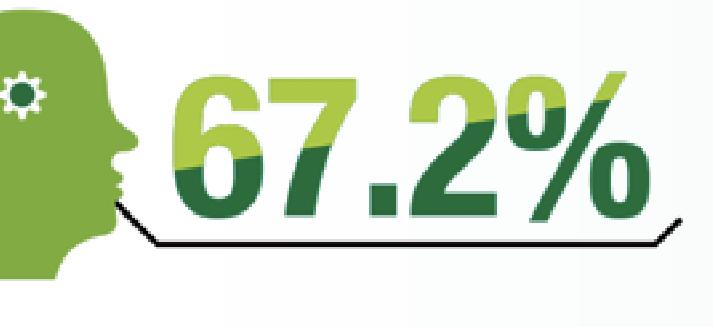
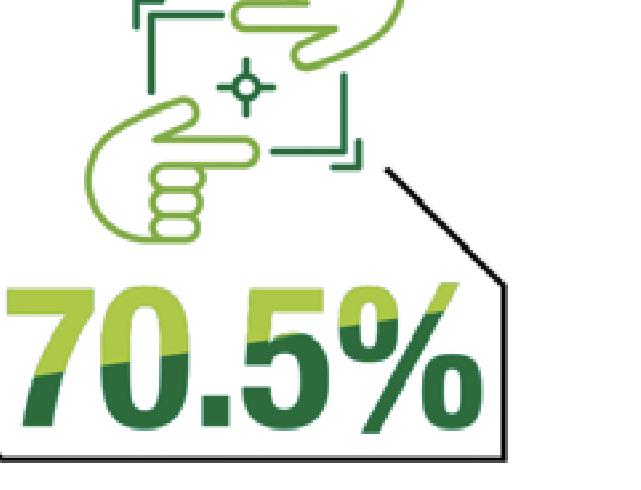
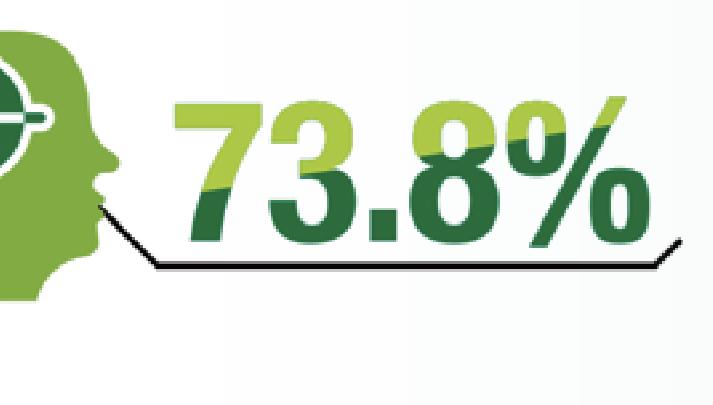

Poor focus
Difficulty in catching up
Compared with face-to-face learning, teachers felt students' concentration (73.8%), interaction with each other (70.5%), and understanding of content (67.2%) were worse via e-learning.




Poor concentration
Poor Interaction with each other
Poor understanding of content
31
Over 70% of teachers agreed the e-learning teaching materials weren't enough (72.1%), and more than 60% said more apps are needed (62.3%).

E-learning teaching materials are insufficient

Key points from in-depth interviews
Without interactions with teachers and classmates, many students felt lonely and depressed when they were continuously taking online classes.
Frontline educators agreed that online lessons had widened learning gaps between SEN students and others. Some even said SEN students were unable to absorb any knowledge via online classes.

Experts asserted that certain education technologies like virtual reality and interactive games can enhance SEN students’ learning experience. However, most of the existing e-learning tools are not tailor-made for their needs which means they are not useful for SEN students.
Here are other remarks made by our Youth I.D.E.A.S. think tank members who also participated in this study:
More apps are needed
Derren Lam, Deputy Convenor and Dicky Kwan, Group Member: More resources need to be provided to SEN students to alleviate their disadvantages. Different types of SEN students need different learning adjustments. We need to facilitate the R&D of e-learning materials and assistive technology for SEN students in the future. The government should set up “Integrated Education Development Fund” to encourage start-ups and academic institutions to use new technology to develop learning tools for SEN students.
Jason Cheung and Connie Tam, Group Members: For schools. teachers and parents, their biggest difficulty is to find and match suitable supporting service for their SEN students. We recommend the government to establish an online learning resources platform that integrate information, activities, training courses and learning materials provided by different stakeholders including schools, NGOs, universities and tech companies. The aim of this platform is to help different stakeholders to find their desired solutions and strengthening cross-sector collaboration.
32
Home is where Hong Kong’s nature is!
Hong Kong’s rich biodiversity is the main reason keeping wellness instructor Lawrence Tai living in Hong Kong. He explains more in our new feature series, Homecoming.

• Hong Kong’s nature is a main reason that is keeping Lawrence Tai, a former civil servant turned wellness instructor rooted on home ground.

It is the simple appreciation of biodiversity in Hong Kong that former civil servant turned wellness instructor Lawrence Tai decided to stay in Hong Kong.
Ironically, he was never keen to head outdoors when a child. “I was glued to my computer and liked staying at home. The thought of heading outdoors was a chore.”
However, things changed after Lawrence graduated from Hong Kong university and joined a local government

• 香港豐富的生物多樣性,是其中一個令戴履宙留下來的關鍵 原因。他放下公務員的身份,現職為身心健康教練,將進駐 我們的新專欄系列「回家」,請大家密切留意。

agency full-time. The newfound love for outdoor fitness with different groups of like-minded friends made Lawrence realise how beautiful Hong Kong is. Lawrence adds that one of the most extraordinary things about the city is that nature flourishes even in the heart of the concrete jungle and which are easily accessible by the public transport system. So, for example, he could choose from kayaking at the Geopark in Sai Kung; doing animal flow yoga at Tamar Park; joining trail races at the Aberdeen reservoir to watching the sunrise at Lantau Peak.

Gwen Sin
33 Homecoming
Photo credits: Body.Nature.Mind
Hong Kong being home to an eclectic mix of individuals and cultures from all parts of the world also means there are always new friendships made amid the new experiences for Lawrence. He recalls that he has made so many good friends from the United States, Philippines, Switzerland, Malaysia, Singapore, South Africa, France, and Thailand in his local expeditions that he is just waiting for more of his overseas friends to return to Hong Kong, now that COVID-19 has stabilised.
“The lockdown period during COVID-19 was a good time of soul-searching for me on what I long to do, what I am good at and enjoy doing to become the person I wish to be. It was also when I started attending online classes on forest bathing*; gong and sound healing and animal flow yoga. I enjoyed the interactions with different groups of people, and it gave me sufficient clarity to give up a stable job and become a full-time wellness instructor instead.”



As a full-time employee, it was a stable and routined structure where Lawrence’s duties included inspection, licensing, customer service, and other administrative tasks.



But when it comes to being self-employed, Lawrence has to think about finances, scheduling, and all practical matters that are worthy of concern in a relatively expensive metropolis like Hong Kong. Nevertheless, Lawrence decides to persevere in his decision as he only has “one life,” and the feedback received from his participants has been nothing but positive and encouraging so far. He has led local halfday expeditions to Tai Po, Mui Wo and organised regular yoga sessions at Tamar Park and Zhongshan Park. Lawrence strongly believes Hong Kong’s biodiversity and ease of accessibility create a mighty healing power that is good for physical and mental health. In the woods, Lawrence often encourages his participants to fully immerse in nature and reconnect with the environment through all five senses: touch, hearing, smell, sight, and sometimes even taste.

Lawrence concludes that turning into wellness has reaffirmed his choice and direction in life. He adds, “We should remind ourselves that we shouldn’t be defined by a job title or how the world defines us. Instead, we should strive to find new meaning in our lives. The sky is our only limit!”





34 Homecoming
Hong Kong's biodiversity is so beautiful and the ease of accessibility make it convenient for us to go and fully immerse in it.
Reference:












*Nature therapy originates from the Japanese practice of shinrin-yoku or “forest bathing”, which was developed in the 1980s.
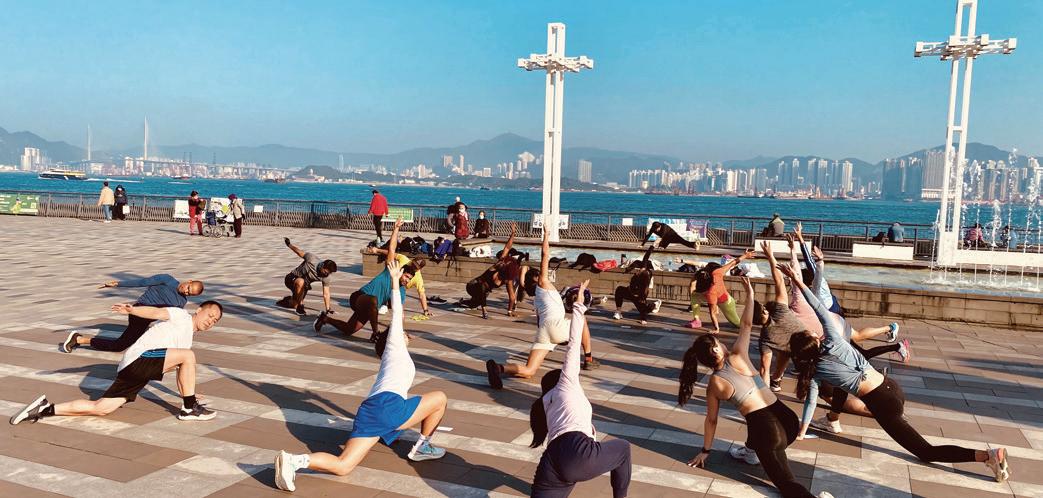





35
Photo credits: Body.Nature.Mind
The Importance of Health and Nutrition in Adolescents







 Alana de Blank
Alana de Blank

What leads to the rise of obesity among youth? A lot lies in nutrition which this article seeks to explore.


We live in a world where we are constantly bombarded with health and nutritional issues. Around 20% of the 1.2 billion adolescents between 10 and 19 years old suffer from obesity. Young children consume an average of 362 calories per day just from added sugars, 10% more than what dietary guidelines recommend. The current youth’s affinity for unhealthy foods is a pressing issue which needs to be resolved.
Adolescents need sufficient energy intake in order to support the dramatic growth they undergo. Generally, girls aged nine to 18 years old should consume 1,400 to 2,400 calories a day and boys aged of the same age range should consume 1,800 to 3,200 calories daily. These caloric needs vary based on activity level; age and so. The extra energy needed for older and more active people should be accounted for in order to support adequate nutrient intake and healthy body weight.

However, in the past few years, there has been an exponential increase in the consumption of unhealthy foods which has led to a drastic increase in obesity amongst the youth population. Over the last 40 years, portion sizes and calorie

intake have increased by 20%. But what has caused society to spiral into a hole of poor eating habits? This rise in obesity is also due to our overall behaviour patterns changing. People are becoming more reliant on processed foods that are high in fat, salt or sugar, whether that be due to socio-economic issues or the false advertising that surrounds us every day.
Children who suffer from obesity are more likely to become overweight or obese adults which is a major risk factor for several diseases later in life, including Type 2 diabetes, strokes, cardiovascular disease, and certain cancers. If a child gains weight inappropriate for growth, it means change is necessary. Sedentary activities such as watching television and playing video games should be discouraged and more children should take part in physical activity. The goal is not weight loss but rather changing the damaging eating habits we have developed over the past years. Healthy eating behaviours adopted during adolescence are more likely to continue to adulthood allowing us to create a healthier and happier population.


36
Features
The number of adolescent girls suffering from anaemia is ever-increasing. About 20-25% of them suffer from anaemia and the impact is more profound in low- and middle-income countries due to a lack of availability of healthy and nutritious foods. Anaemia has been linked with decreased productivity, reduced growth and development, severe fatigue, and heart problems, and in many severe cases, it can be fatal. It is crucial that we encourage adolescents to consume more nutritious foods so they can have a diet rich in iron and vitamins which will allow them to reduce their risks of developing deficiencies such as anaemia.
Another common concern amongst adolescents is acne, which around 80% of teens experience. There is an observed link between the over-consumption of junk foods and increasing acne concerns. Another physical consequence of a poor diet may be low self-esteem. Stress, low self-esteem, and other psychological and emotional issues are all factors that can lead to people developing eating disorders. Disordered eating is a complex, significant mental health condition that affects more than 70 million people worldwide, with







90% of these people being women between the ages of 12 and 25. It involves extreme behaviours related to food and exercise. Disordered eating can impact an individual’s ability to function normally and participate in all their usual daily activities, and these consequences can follow them for life.









Adolescents face several threats to their health and nutrition. It is not only beneficial but is essential for them to have a healthy, safe and balanced diet as this is a basic human need. We need to increase education about this issue so people can make more educated choices about the foods they choose to eat, so they can access a healthier and balanced lifestyle.
Alana de Blank was studying at an international school in Hong Kong before continuing with her lower sixth education in the UK currently. Her fondest memories of Hong Kong would be time well-spent at the beach or the park with her family and dog, as well as enjoying the delicious food in Hong Kong. She enjoys sports, specifically netball and athletics, and reading.
37
Sustainable and Climate-friendly Ways of Travelling


Sustainable travelling not only helps to protect the environment, but is also a win-win option which allows travellers to fully immerse in a different culture. Read on to find out more on the benefits of travelling in more sustainable ways that are good for the heart, soul and also the environment-at-large.
There is a recent spike in overseas travelling, with quarantine requirements minimising and the lifting of COVID-19 entry restrictions all over the world. However, aviation is known as a high carbon emission transportation method, where it is estimated that the carbon footprint of a return flight from Hong Kong to Tokyo could be equivalent to 12.6% of per capita annual emission for Hong Kong alone. The strong rebound in tourism after COVID-19 has caused











carbon emission from planes to be rising even more rapidly.



The best way to reduce the carbon emission caused by travelling is to reduce the number of times taken to travel by flight. Understandably, the urge to travel overseas leisurely will arise, after long stretches of COVID-19 related lockdown. And there are still many other ways to make your overseas travel more climate-friendly.
Travel Overland


Flights are the least sustainable way to travel. For example, for a 200-mile trip, the CO2 emission of a flight would be 109 pounds per passenger, while the CO2 emission of a train or charter bus would only be 26 and 19 pounds per passenger. It would be more environmentally friendly to replace short-haul flights with overland travel, if the destination is accessible by train or other overland transportation.
Walk, Cycle and Hit the Public Transport

Walking and cycling would be ideal options to reduce carbon footprint during our holidays. In fact, choosing cycling over driving would help reduce the CO2 emission by 75%. Nowadays, some popular travel cities such as London, Paris, Washington DC, Tokyo, Kyoto and Osaka allow tourists to rent or borrow bicycles which make cycling trip much easier. Taking trains could reduce the per capita carbon emission of travelling, rather than renting cars as a transport means for longer distances. Travelling by train also provide a better experience of immersing and understanding the local culture.

38
Features
Book Direct Flights Instead of Connecting Flights
Travelling by direct flights produce less carbon footprint than that travelling by connecting flight. The carbon emission from the aircraft is mostly released during landing and take-off phases, even though it is for the same destination.
Shop and Support the Local
Sustainability is not only about environmental protection; sustainability in social and economic aspects should also be considered. Purchasing products and buying services from small local businesses help to ensure that the local residents and community are also benefiting from the tourism boom. For example, staying in small hotels, buying from the local market, joining the local tour with local tour guides, and also eating in non-chain restaurants.
See Wildlife and Animals in their Natural Dwellings
Joining responsible wildlife tourism and visiting safaris are good reminders that animals should be seen in their natural habitats, which is another option to travel eco-friendly and sustainably.
Youth-led Decarbonisation Platform
Youth-led Decarbonisation Platform is launched by HKFYG to provide an online platform for young people to record their daily reduction of carbon emission. The platform helps young people to build a better understanding on the carbon emission of different daily activities. In order to provide incentive for users to nurture their low carbon living style, users can also get rewarded by accumulating their carbon reduction amount. This will encourage more youth to start low carbon living, and to support Hong Kong’s goal in achieving carbon neutrality.
Reference:
1. https://www.cathaypacific.com/cx/en_GB/about-us/environment/ fly-carbon-neutral-fly-greener/offset-your-flights.html





2. https://ourworldindata.org/grapher/co-emissions-per-capita?tab=chart&country=CHN~HKG
3. https://www.future.green/futureblog/save-carbon-biking

4. https://www.bbc.com/future/article/20200218-climate-change-how-to-cut-yourcarbon-emissions-when-flying https://viatravelers.com/sustainable-travel/
5. https://www.bbc.com/future/article/20200218-climate-change-how-to-cut-your-https:// www.bbc.com/travel/article/20110909-travelwise-bike-sharing-around-the-world
39
New Webisodes from "With All Our Might" Series
M21online series “With All Our Might!” delves into trending topics that are close to Hong Kong young people’s hearts. Episodes 2 and 3 are now available, with a focus on housing challenges and carbon footprint reduction in Hong Kong.

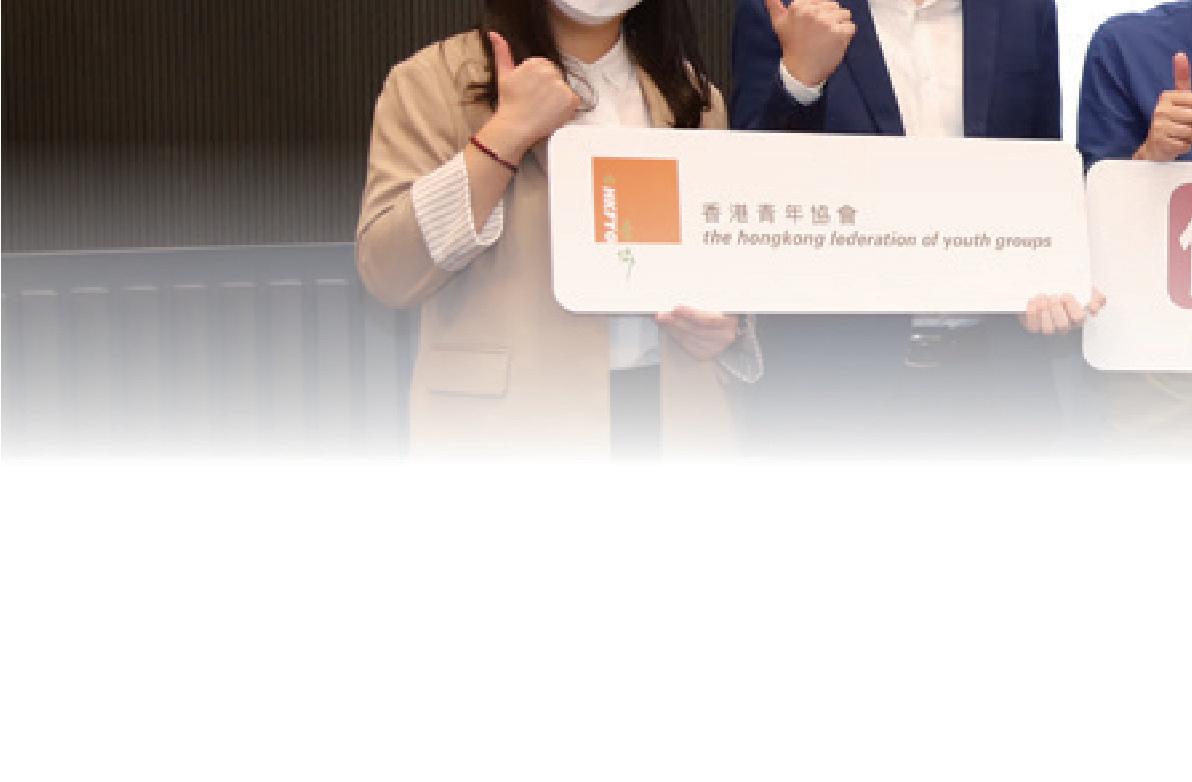
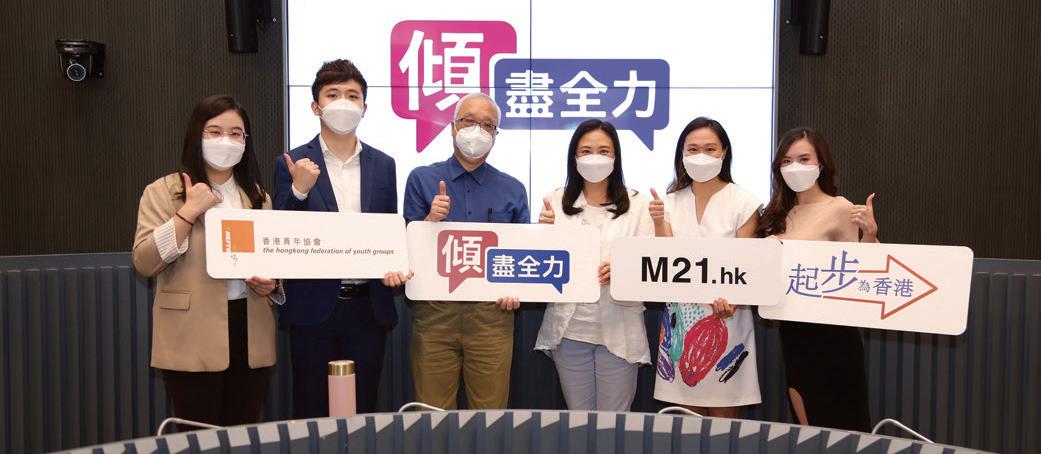
Episode 2: Establishing the Property Ladder
Housing has always been the youth’s concern and also one of the most challenging issues in Hong Kong. Three youth professionals Rex, Tommy, and Koby comment in this webisode that the stakeholders like themselves do not benefit under the current Quota and Points System for public rental housing. At the same time, they belong to the in-between or “sandwiched” cluster that is, the middle-income families that cannot afford to buy apartments at concessionary prices under the In-Between Housing Scheme ( 夾心階層住屋計劃 ), nor do their salaries alone could allow new plans for social upward mobility such as family planning due to high rental fees.
One of the panelists, Under Secretary for Housing, Mr Victor Tai replied that the Hong Kong SAR government will try to source for more suitable land to accommodate more diverse types of housing. Public rental housing remains at a ratio of 7:3 under the Green Form Subsidised Home Ownership Scheme when compared with sales of subsidised housing. With the rise of housing supply, subsidised flats will then also increase, which will greatly benefit all Hong Kongers.
Hence, establishing the housing tiers or “ladder” for youth 「青 年置業階梯」 will greatly benefit youth to decide on their

Watch webisode 2 here!
housing options, and finding greater fulfillment between work and life, add the three young professionals on the panel. They suggest greater governmental regulations for youth put up in youth hostels, such as extending the age limit to 35 years old. There should also be rental subsidies for youth based on their income earnings. They should be given an additional concession when they apply for flats after fulfilling their lease tenure in youth hostels. The three young professionals also opine that members have not been nominated under the “Youth Committee Self-Referral Programme” 「青年委員 自薦計劃」, and they hope it can be promptly established as communication channels for youth to express their opinions.
Legislative Council Member Mr Vincent Cheng commented that housing needs form the fundamental need of every citizen. The housing problem in Hong Kong has been prevalent for many years. He anticipates the government to ramp up efforts on the implementation of various policies in place, and to weigh the considerations on the housing policy of youth putting up in hostels to alleviate their housing concerns and stress.
40 HKFYG News
Episode 3: Carbon Footprint Reduction
While there is growing awareness among youth on environmental issues, the takeup rate and practice of reducing the carbon footprint still needs greater active participation from youth from all walks of life. Three youth professionals including Thomas, Vanessa and Jewel suggest the governmental ban on the supply of disposable plastic tableware by the food and beverage industry earlier than 2024. As of now, there are no significant measures to moot the switch to heavy dining utensils. The youth panelists are also concerned that the transition to discard the use of plastics will be transferred to the use of other non-recyclable materials. Lastly, it also generates a huge amount of garbage, and the youth are advocating for the authorities to step up in their publicity and promotion to better educate the public on waste reduction.
In response during the panel, Secretary for the Environment and Ecology, Mr Tse Chin-wan, shared that the Hong Kong Government is aware of the carbon footprint and is also aiming to achieve zero waste by 2035. Operators have also been requested to reduce the use of nonrecyclable materials when they renew their contract for the “Green Zone” label, such as ensuring recycled bottles are converted to approved qualified ingredients so that lesser plastics will end up at the garbage disposable stations.
Legislative Council Member, Ms Elizabeth Quat also comments that the current application of sustainability research
is very broad. In addition to plastic waste reduction and recycling, such as the use of technology in urban planning and in the area of ventilation such as using air-conditioning. She encourages all present to adopt a lower carbonemitted lifestyle. She also encourages everyone to work hand-in-hand in creating a vibrant ESG (Environment, Society, and Governance) circular flow and usage of higher ESG-rated lifestyle products.
Talent shortage has become a challenge with the rapid rise in sustainability globally. The young professionals point out that while there has been a well-developed ESG accreditation system implemented internationally, the Hong Kong authorities should look into narrowing the gap in the qualifications framework and expect more relevant courses and training for professionals in local institutions. They also suggest the Hong Kong SAR government in taking the lead to organise the Sustainability Summit, where research teams and experts from Hong Kong and overseas can be invited to exchange meaningful dialogues with local companies and young people in promoting the green movement.
“With All Our Might!”
《傾.盡全力》web series

This project is part of the Stepping Forward with Commitment to Hong Kong initiative. The Stepping Forward with Commitment to Hong Kong initiative was launched in the Federation in June 2022, with the aim of garnering participation from more than 20,000 youth on “community building”, “economic development” and “Greater Bay Area development” to work in unison to create a new era for Hong Kong. “With All Our Might!”
《傾.盡全力》 is one of the focus projects of Stepping Forward with Commitment to Hong Kong . Five thematic episodes have been scheduled for release. To watch the programme, please visit the website m21.hk.
Watch webisode 3 here!
傾‧盡全力 | 愛‧在全城
41 HKFYG Tribute
Striking a Chord at this year’s


Hong Kong International a cappella Festival

TheFederation’s annual signature a capella event “Hong Kong International a cappella Festival” made a comeback this year! The best of Eastern and Western melodies were presented by renowned local and overseas vocal groups in this amazing musical showcase.



From Disney tunes to Beyonce hits, highlights of the Festival included many popular hits performed at the “International a cappella Extravaganza”, the “a cappella Gala” and the “a cappella Community Day”. The Federation’s Executive Director, Mr Andy Ho said, “Since 2009, the Federation has been a longtime supporter of a cappella music, where we encouraged young people to become involved in this musical genre with this precision and perfectly harmonised choral singing. Our Festival has inspired more than 250,000 young people over the past 11 Hong Kong International a cappella Festivals.
“This exceptional milestone would not have been reached without the dedicated contribution of performers, educators and partners along our way. This year, we are privileged to have some favourite performers, along with new friends join in the Festival.”
The “Hong Kong a cappella Competition” as sponsored by The Hong Kong Arts Development Council also brought together more than 30 groups from secondary schools and open categories to vie for highly coveted top honours. The public also had opportunities to meet the a cappella groups in person during the “a cappella Community Day”.
The Cultural Services Unit of The Hong Kong Federation of Youth Groups is committed to promoting the development of local a cappella talent and creating more opportunities and space for young people to participate in culture and the arts. They have had more than 500 a cappella training sessions and activities, with more than 300 secondary schools and more than 370,000 participants having taken part.

42 HKFYG News
Participating a capella groups:
• Acapellago (PH)
• Freedom’s Boombox (US)
• Narin (KR)

• Pipeline Vocal Project (US)
• Kaichiro Kitaura (JP)
• Boonfaysau (HK)
• VSing (HK)
Pipeline Vocal Project Freedom’s Boombox
Pipeline Vocal Project was initially founded by Lisa Hawkins as a project to help cultivate the contemporary a cappella scene in Alaska (US), where contemporary vocal music had not made its way into the local culture quite yet. She started recruiting for the project in 2019 and through social media and hometown connections, found two singers, Molly Dieni and Lisa Hawkins to join her mission. Their first interaction together was the first rehearsal. Since then, they’ve had many memorable experiences together, including their tour in Lithuania where they had the opportunity to collaborate with Freedom’s Boombox (FBX) for the first time. They were extremely excited to be reuniting with FBX in Hong Kong to perform together again. As this will be their first time performing in Asia, the Alaskan trio is extremely elated to be performing at the Hong Kong A Cappella Festival.
In a world where there is so much negativity, especially on self-image from social media, the trio thinks it’s so important to have uplifting, danceable music that brings us positivity; both musically and lyrically. That was why Pipeline Vocal Project collaborated with FBX’s called “I Love Me”. The song also held much significance to them because we performed it with FBX on the “Good Morning Lithuania” show, one of Lithuania’s most popular TV shows, called “Labas Rytas Lietuva” [“Good Morning Lithuania”] highlights different towns across that country.


Pipeline Vocal Project’s advice to other aspiring a capella singers is, “no matter how big your goals are, don't let it intimidate you from taking the first step.”
Freedom’s Boombox (FBX) was formed in 2016. It initially started as a fun trio video with Freedom Young, Richard Steighner & Christopher Diaz from the vocal group The Exchange. The video went viral and so the trio decided to keep on making videos which led to them getting gig offers! One of their favourite experiences was travelling to Madagascar with eight boys of Zaza Kanto. In FBX’s words, working with them and watching them shine on stage was such an incredible moment! Coming to Hong Kong is dear to their hearts, as the people from this city have always shown their former group, The Exchange, a lot of love! They are certainly so excited to come back!
Finally, their advice to any aspiring a capella groups is to find the right people, who doesn’t have to be the most talented people, but also fun to work with and have similar goals for the group. Members of the group should feel like an awesome journey to be experienced together instead of feeling like a chore.
In 2016, The Federation won the “Art Education Award (Non-School Category)” issued by The Hong Kong Arts Development Council. The Federation is proud that such as the “Hong Kong International a cappella Festival”, “a cappella Education Programme” and “Hong Kong Melody Makers” have made key contributions to the development of local culture through promoting the appreciation and learning of a cappella music among youth, and also nurturing many a cappella groups. For more details about the Festival, please visit csu.hkfyg.org.hk.

43
"Inno Impact" Awards Presentation Ceremony Announced Five Winning Teams
The Federation launched a new programme, the Inno Impact Project ( 獻計有方 ). The purpose was to gather 20,000 young people on ways to contribute to the good of the community. Five selected projects received up to HK$200,000 each with entrepreneurship training, mentorship support, networking, free venue support, and promotional opportunities.
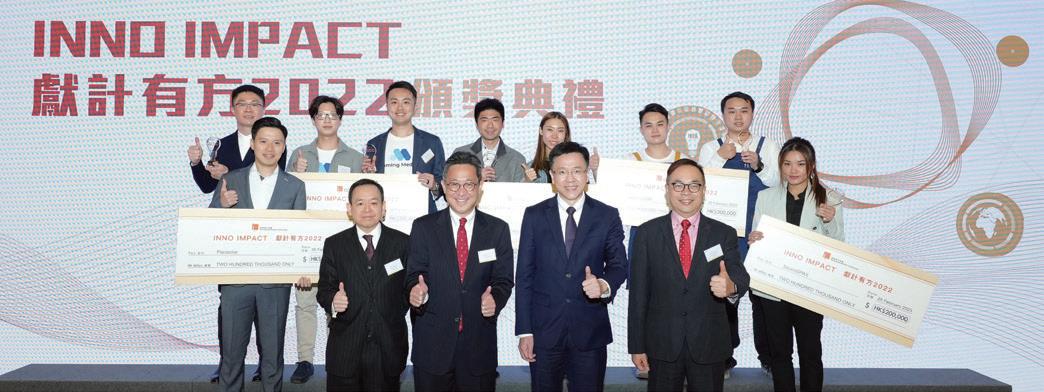
The Federation has supported entrepreneurship since the year 2000 and has nurtured a large network of entrepreneurs and business partners. It is also the founding sponsor of the Hong Kong General Chamber of Young Entrepreneurs (HKGCYE). Under the Stepping Forward with Commitment to Hong Kong initiative, the Inno Impact Project aims to encourage more young people aged 18 to 35 years old to submit innovative proposals to create social value and propose feasible solutions for Hong Kong.
Five thematic areas were outlined:
1. Financial innovation and technology
2. Elderly care
3. Housing planning

4. Sustainable development
5. Cultural and creative industries
The finale saw five outstanding innovative and creative proposals shortlisted. The five award-winning teams included: Used Clothing Remaking, Natural Home Cleaning Products, Stroke Rehabilitation Medical
Robots, Regenerative Energy Systems, and 3D Virtual Musicians. Each received HK $200,000 startup fund and two-year incubation, including: one-year free desk hire, professional mentor guidance, network recommendations, project promotion and other full range of entrepreneurial support. This inaugural launch attracted more than 200 young people in submitting 130 proposals, where nearly 80% of which are related to sustainable development, and also from the cultural and creative industries.
The Federation’s Executive Director, Mr Andy Ho said that, unlike general entrepreneurship competitions, Inno Impact focused on the social value, benefits and rewards that the programme brings to the community or to specific groups of beneficiaries, as their continued commitment to Hong Kong. Mr Ho thanked the reviewers, professional mentors, supporting agencies and partners for their support. He also thanked the youth for their innovative ideas to create a new vision for Hong Kong.
44 HKFYG News
The Five Winning Teams
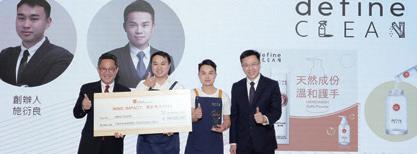

UNI Green is a social innovation project connecting schools and retired garment workers to recycle and upcycle old school uniforms and educate primary and secondary students on sustainable fashion.

“UNI” stands for Uniform and Unique. The programme helps repurpose old uniform to unique souvenirs. The schools joining the programme will first collect the old uniforms and
UNI Green define CLEAN
Define CLEAN is a social start up offering plant-based powder-form personal care and household cleaning/ disinfecting products without single-use plastic packaging and is 98% lighter than the general products in the market. This reduces carbon emission found in packaging generated by single-use plastic packaging and transportation.


The mission of define CLEAN is 3S and 1H: Save on Space: Our powder-form solution significantly saves storage space.
Fleming MedLab


Fleming MedLab is a medical robotics startup focusing on stroke rehabilitation. We help stroke survivors to walk again and recover their brains with our wearable robots (exoskeletons).

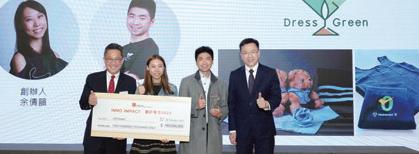

We designed our medical-grade robots with our patented technology based on neuroscience principles. With our machine-learning algorithm, we help therapists and
let other parents take them. For the uniforms that are of poor quality or are not taken by the parents will be upcycled and repurposed as school souvenirs or to be used in the upcycling workshop. We promote inclusive economy by hiring housewives and elderly to assist in the garment work and upcycling workshops.
Being a platform for garment workers to do good in the community and earn livings at their retired age, UNI Green alleviates poverty and advocates social exclusion, alongside extending and enhancing the lifespan and value of the pre-loved uniforms.
Save on Spending: Eliminating excess packaging, define CLEAN is sold at more affordable prices due to lower production cost.
Save the Earth: Our products address climate change by reducing transportation carbon emission.

Help those in Need: We offer job opportunities to grass-root families that are affected by COVID-19.

define CLEAN powder-form cleaner solution is developed, designed and made in Hong Kong. Our product is made of plant-based ingredients, and does not include colours, fragrance and VOCs.
patients improve their recovery efficacy and predict their prognosis.
We work directly with hospitals, rehabilitation centers, and physiotherapy clinics. By helping patients early, we can maximize recovery outcomes.
Currently, we have 3 US patents and are in the 1st clinical trial phase. We are ready for a soft launch to the market in 2023 Q2.
Our goal is to help 41,000 stroke patients daily to regain mobility, rebuild neural pathways, and get back on life.

45
of the land for both photovoltaic power generation and agricultural purposes; while the environment could be preserved through the generation of green energy, farmers’ businesses could also benefit from the extra source of income and the increase in their crop yield.
Our mission is to help organizations adopt renewable energy to achieve carbon neutrality, sustain their business, and enhance land use.
With global warming causing rapid increase in global temperatures and an annual surge of 25-40% in electricity fees, Parasolar thinks that it is time to strive for carbon neutrality in Hong Kong in a bid to combat this wider issue, Meanwhile, we also notice the way local sunset industries have been more vigorously urged to cease operation in recent years, not to mention the toll which the upcoming bills hike may further take on these businesses.
In light of this situation, our team at Parasolar - which has extensive technical knowledge and working experience in the renewable sector – has figured out the ideal solution to all these problems - Agrivoltaics. By designing and installing Agrivoltaics in Hong Kong’s farmland, we could enable simultaneous use



Parasolar SoundSPAX


SoundSPAX strives to build a music label in Hong Kong which focuses on combining 3D technology with music and performances to produce virtual performances for our musicians and corporate clients .



Our vision is to bring new experiences to Hong Kong, and to produce more digital entertainment products that are closer to the younger generation of the people in Hong Kong.
Research has shown that Agrivoltaics would not impair crop growth, it actually improves the yield of many crops due to the optimal spacing, temperature and humidity level provided. In fact, agricultural product appeared to be fresher under Agrivoltaics. We believe that farming and green energy can coexist and mutually benefit each other and we are thrilled to see more people adapting Agrivoltaics.
46 HKFYG News
"Youth Development Blueprint" Post-Announcement Dialogue by M21

Whatdoes the future hold for Hong Kong’s young people? Youth leaders from the Federation had a fruitful Q & A session with Secretary for Home and Youth Affairs Alice Mak.
Youth like startup entrepreneur Kelly Cheng; creative professional Fish Wang; lawyer Tony Lau and green finance analyst, Jewel Ho are deeply concerned about global perspectives; entrepreneurship; community engagement; talent management, and sustainability. On a deeper and personal level, these young people are eager to find out if the Hong Kong SAR Government has sufficient policy measures; concrete initiatives; educational channels for them to acquire such knowledge.
Thanks to The Hong Kong Federation of Youth Groups’ online media channel, M21.hk, they were joined by other 160 youth and had a rare opportunity to ask these burning questions upfront and personally with Ms Mak as a post-announcement dialogue in a candid and light-hearted manner.
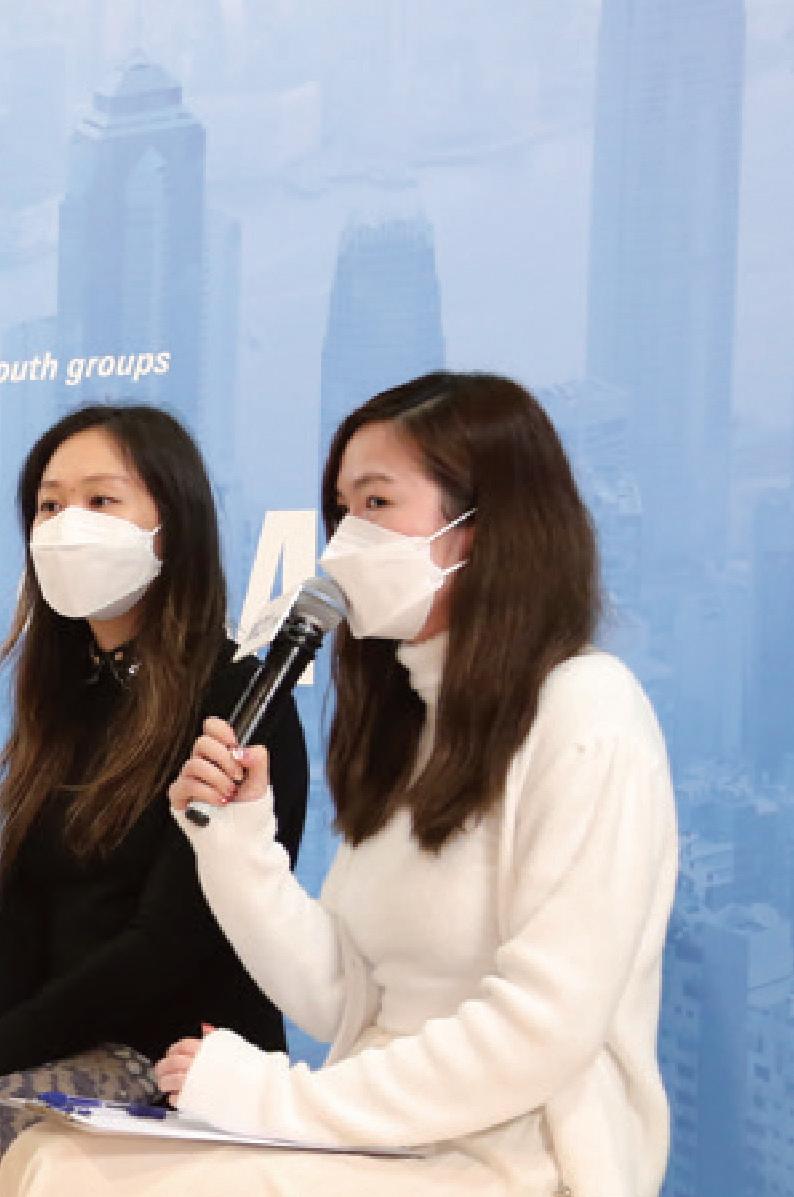


Ms Mak’s great candour on the various topics broached was well-received by the youth present for the online live streaming session. The Federation’s Executive Director Mr Andy Ho was delighted with the vibrant discussion

and robust participation and commended the Government’s efforts in youth development matters. He also elaborated that Hong Kong youth from different backgrounds have different needs to be offered a wide range of opportunities to make it in life. It could be in the area of mental health, social participation, career development, or entrepreneurship. The Federation will strive to keep creating such favourable opportunities for the young people to develop their strengths from as an individual in terms of social, national and global opportunities so that they could contribute positively to Hong Kong collectively.
The online live streaming session can be replayed from this QR code or be launched from m21.hk.

47
Community Engagement through Project Neighbourhood First
The Federation's Project Neighbourhood First has come a long way since its official launch in 2011. A youth-led initiative, the Federation’s aim is to empower youth in meaningful activities for better engagement and nurture lasting relationships between local communities.
The Hong Kong Federation of Youth Groups’ Project Neighbourhood First is a youth-led community care initiative set up with four components in mind: youth leadership training; volunteer training; nurturing online connections and providing regional collaborations. With these fundamentals in mind, the overall aim is to inspire new synergy among the youth leaders and the local communities.
Since its official launch in 2011, more than 3,000 youth volunteers aged 14 to 35 years old have formed more than 100 “Neighbourhood First teams” to embark on different community projects in different districts of Hong Kong.


i. Promote community inclusiveness and cohesion among neighbours;
ii. Improve the young people’s self-confidence through the empowerment of community participation;

iii. Nurture social capital through the vast network of different government agencies in different industry sectors for further collaboration;
iv. Strengthen the exchange of regional information through online platforms with good community resources for mutual partnerships;
v. Establish a successful online platform for greater outreach through technological advancement.
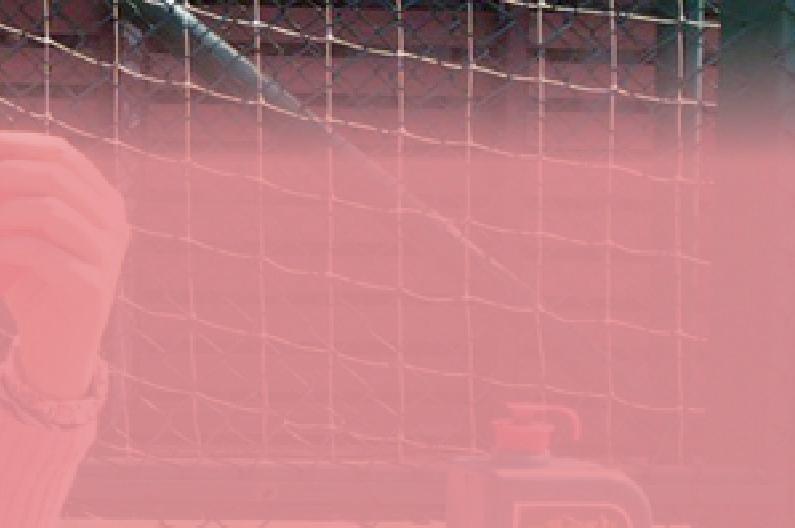
This yearly event (except for 2020-2022 due to the COVID-19 outbreak) is held in all 18 districts in Hong Kong during the Lunar New Year since 2012. The youth leaders will organise dinners mainly for the local communities approached by the Neighbourshood First teams. The turnout is usually well attended by 12,000 young people, neighbours and other stakeholders within the community of different districts collectively bonding over a good festive feast.
In the inaugural edition held on 19 March 2023, this event aimed to promote community engagement through four core topics: Walking Down Memory Lane; Introducing the Digital World; Understanding Creative Services, and Participating in Environmental Sustainability Activities. It was well supported by talented youth volunteer leaders and corporate partners.
Find out more!
To understand more about Project Neighbourhood First, please scan the QR code.
Neighbourhood First Reunion Lunch
48 HKFYG News
Neighbourhood First Festival
All-in-one Learning Environment with Easy School Connect
The Easy School Connect platform was set up by the Federation as a better learning and growth environment, with the aim of providing salient information for young people as a dedicated online portal.
Purposes
To provide school services for teachers from the HKFYG to kindergartens, elementary schools, high schools and tertiary institutions as a one-stop online service portal.


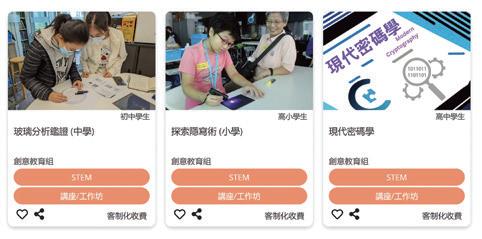

Services
• Health and Wellness
• Employment
• Leadership Training
• Parenting Advice
• Provision of Venue Facilities
Functionality for Teachers
• Prompt Enquiry Response Service
• Designated School Liaison Officers

• All-Rounded Support Services from the Federation
• Educational Resources for Teachers and Welfare Resources for Students
Contact
Email: enquiry@easyschoolconnect.hk 49
HKFYG 2023 – 2024 Annual Plan
The world is heading toward normality after a three-year hiatus due to the COVID-19 virus. Injecting impetus and helping young people return to normal life will be the year’s main objectives. The HKFYG has launched “ Stepping Forward with Commitment to Hong Kong ”, a new campaign to ensure social integration for the youth with the community through volunteerism. The overall purpose is to nurture their commitment to community service and serve as future leaders to bring forth Hong Kong to future success.
Social and Youth Trends
• Youth unemployment remains the focus as the economy recovers from the COVID-19 epidemic and the development of young people from disadvantaged families was affected. Upskilling opportunities in term of acquired knowledge and training will be provided for affected youth to support their transition and career advancement.
• Strengthening social cohesion and nation-building are also core priorities. Many said that they have a strong desire to contribute to Hong Kong, but looming ambiguities about the city’s prospects are of concern, with emigration as a strong opinion. More opportunities should be provided for them to participate and have a stake in Hong Kong's development.
• Appropriate assistance for young people to return to learning and socialising should be provided for the betterment of their physical and mental health. Programmes related to these areas will be beneficial for them to adapt back to pre-epidemic days.
• Relevant education and law-abiding awareness should be advocated. Youth are sometimes prone to risky behaviours and this is evident from heightened fraud, extortion, and drug abuse cases involving young people.
• Practicality of actions towards environmental concerns need to be strengthened. Although more young people are becoming aware of sustainable issues such as carbon reduction and recycling, they might not adopt green living habits for convenience's sake.
Based on the review of the above trends, the Federation outlines the following directions for 2023-2024:
Digitalisation
• Develop M21 “ICT Academy” (數碼媒體學 院) and Smart S.P.O.T (智慧青年空間) to provide the latest digital technology facilities and professional training for youth who wish to embark into digital related careers.
• Implement the HKFYG “Three-Year ICT Strategy Plan” (資訊及通訊科技三年策略
計劃) to strengthen infrastructure and reform the service practices.
Upskilling
• Provide comprehensive "Future Skills" training, including Life Planning activities, STEM programmes etc. to support youth to acquire new knowledge and skillset.
• Cultivate youth mentors by offering internship opportunities and providing a platform that enables youth to acquire practical experiences and embark on diverse career options.
Sustainability
• Strengthen sustainable development education through experiential learning and practices to help young people establish low-carbon lifestyles.
• Nurture Youth Leaders with green mindset to lead our society to climate change. Establish “Wellness Plus Complex” (青年全 人健康中心) that provides health management services, such as identifying and supporting young people at risk of health issues in the community.
• Implement the HKFYG's carbon reduction goals and work with young people to achieve carbon reduction goal.
Mainland Strategy
• Resume the Federation’s flagship exchange programmes, such as the “Youth High Speed Rail Trip” (高鐵青年號) and the “Dragon Jamboree” (龍騰樂韻—萬人青年中樂
匯演), a variety-filled performance featuring 10,000 youngsters to help young people
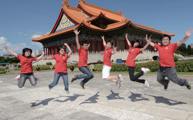


understand cultural significance.
• Provide employment and entrepreneur support to young people who are interested to work in Mainland China and be better integrated with the overall national development.
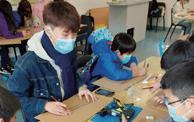
Please contact the Corporate Planning and Staff Training unit at cp@hkfyg.org.hk for further inquiries about the HKFYG’s Annual Plan.
50
TheFederation has consulted various salient stakeholders as well as taking into consideration of the current trends to develop the 2023 to 2024 Annual Plan. Here are the key points.
HKFYG News
Office and Unit List
HKFYG Website: hkfyg.org.hk M21 Multimedia Web: M21.hk
Student Guidance Team (Kindergarten)
2395 0162 sgt@hkfyg.org.hk
Media Counselling Centre 2788 3433 mcc@hkfyg.org.hk
Media Counselling Centre (Youthline) 2777 8899
Media Counselling Centre (Open Up) Website: www.openup.hk
Media Counselling Centre (uTouch) 2788 3444 utouch@hkfyg.org.hk
Education Services
Education Services Unit
3755 7107 education@hkfyg.org.hk
Ching Lok Kindergarten/ Ching Lok Nursery 2886 8856 cl-swh@hkfyg.org.hk
Ching Lok Kindergarten (Yaumatei) / Ching Lok Nursery (Yaumatei)
2385 6868 cl-ymt@hkfyg.org.hk
KK Cheng Kindergarten 2385 2622 kkc@hkfyg.org.hk
Lee Shau Kee Primary School 2448 1011 lskps@hkfyg.org.hk
Lee Shau Kee College 2146 1128 hlc@hlc.edu.hk
Continuous Learning Centre 2130 4000 clc@hkfyg.org.hk
Living Life Academy 2130 4000 lla@hkfyg.org.hk
Parenting Services
Jockey
Jockey
lh@hkfyg.org.hk
3257 tp@hkfyg.org.hk
Jockey Club Cheung Wah Youth S.P.O.T. 2669 9111 chw@hkfyg.org.hk
Jockey Club Kwai Fong Youth S.P.O.T. 2423 1366 kfit@hkfyg.org.hk
Tsuen Wan Youth S.P.O.T. 2413 6669 tw@hkfyg.org.hk
Tsuen King Youth S.P.O.T. 2498 3333 tk@hkfyg.org.hk
Jockey Club Kin Sang Youth S.P.O.T. 2467 7933 ks@hkfyg.org.hk
Jockey Club Tin Yiu Youth S.P.O.T. 2445 4868 ty@hkfyg.org.hk
Jockey
tyt@hkfyg.org.hk
hsk@hkfyg.org.hk
Parent Support Network
2402 9230 psn@hkfyg.org.hk
Family Life Education Unit (Eastern/Wanchai District) 2567 5730 psn-ew@hkfyg.org.hk
Family Life Education Unit (Kowloon City District)
Family Life Education Unit (Tai Po/North District)
Family Life Education Unit (Tsuen Wan/Kwai Tsing District)
2774 3083 psn-knc@hkfyg.org.hk
2658 3097 psn-tpn@hkfyg.org.hk
2490 2662 psn-twkt@hkfyg.org.hk
Creativity Education and Youth Exchange
Creative Education Unit
2561 6149 ce@hkfyg.org.hk
Centre for Creative Science and Technology 2561 6149 ce@hkfyg.org.hk
Youth Exchange Unit 3586 8448 ye@hkfyg.org.hk
Mainland Affairs Office 3705 1501 mao@hkfyg.org.hk
Zhongshan Sanxiang Youth Training Centre 3586 8448 ye@hkfyg.org.hk
Leisure, Cultural & Sports Services
Cultural Services Unit 2395 5753 csu@hkfyg.org.hk
Community Team Sports Office 3611 6670 cts@hkfyg.org.hk
Tsuen Wan Indoor Sports Centre 2413 6669 twisc@hkfyg.org.hk
Camps Unit 2395 5759 camp@hkfyg.org.hk
Jockey Club Sai Kung Outdoor Training Camp 2792 2727 otc@hkfyg.org.hk
Lamma Youth Camp 2982 1929 lyc@hkfyg.org.hk
Stanley Outdoor Training Camp 2813 8886 s@hkfyg.org.hk
Tai Mei Tuk Outdoor Activities Centre 2664 4686 tmt@hkfyg.org.hk
Extended Service for Young Night Drifters
Youth Support Scheme
yvn@hkfyg.org,hk
www.openup.hk
8866 osw-skwts@hkfyg.org.hk
2202 ynd@hkfyg.org.hk
4711 yss@hkfyg.org.hk
Anti-drug Service 2473 0133 ad@hkfyg.org.hk
Counselling Services
Clinical Psychology Unit
7021 wp@hkfyg.org.hk
Wellness PLUS (Hong Kong) 3755 7021 wp@hkfyg.org.hk
Wellness PLUS (Kowloon)
The HKFYG Leadership Institute – Lodge 2169 0255 info@leadershipinstitute.hk Research and Publications
Youth Research Centre 3755 7022 yr@hkfyg.org.hk
Professional Publications Unit 3755 7108 cps@hkfyg.org.hk
Special Services
The HKFYG Youth Hostel PH2 2656 0009 ph2@hkfyg.org.hk
WL Residence 2915 5532 wlr@hkfyg.org.hk
Café 21 3188 5792 cafe21@hkfyg.org.hk
PH3 5933 6323 ph3@hkfyg.org.hk
Organic Farm 2838 4808 organicfarm@hkfyg.org.hk
Hydroponic Farm 9333 2551 hf@hkfyg.org.hk
The Dragon Foundation Secretariat 2811 2779 info@dragonfoundation.net
Development and Support
Partnership and Resource Development Office
3755 7103 partnership@hkfyg.org.hk
Corporate Planning and Staff Training Unit 3755 7088 td@hkfyg.org.hk ; cp@hkfyg.org.hk
Corporate Communications Office 3755 7022 cco@hkfyg.org.hk
Sustainability Unit 3755 7110 sst@hkfyg.org.hk
User Experience Unit 3905 1546 ue@hkfyg.org.hk
HKFYG Building Management Unit 3755 7098 bm@hkfyg.org.hk
Head Office 2527 2448 hq@hkfyg.org.hk Youth S.P.O.Ts Youth S.P.O.T. 21 3755 7021 spot21@hkfyg.org.hk Heng Fa Chuen Youth S.P.O.T. 2557 0142 hfc@hkfyg.org.hk Jockey Club Shaukiwan Youth S.P.O.T. 2885 9353 sw@hkfyg.org.hk Jockey Club Hung Hom Youth S.P.O.T. 2774 5300 hhit@hkfyg.org.hk Jockey Club Farm Road Youth S.P.O.T. 2715 0424 fr@hkfyg.org.hk Jockey Club Wang Tau Hom Youth S.P.O.T. 2337 7189 wth@hkfyg.org.hk Jockey Club Ping Shek Youth S.P.O.T. 2325 2383 ps@hkfyg.org.hk Jockey Club Tseung Kwan O Youth S.P.O.T. 2623 3121 tkoit@hkfyg.org.hk LOHAS Youth S.P.O.T. 2702 2202 ls@hkfyg.org.hk Felix Wong Youth S.P.O.T. 2706 2638 fw@hkfyg.org.hk
Club Verbena Youth S.P.O.T. 2997 0321 vb@hkfyg.org.hk
2647
S.P.O.T. 2698 5565
Club Jat Min Youth S.P.O.T.
0744 jm@hkfyg.org.hk Lung Hang Youth
2656
Tai Po Youth S.P.O.T.
Club Tin Yuet Youth S.P.O.T. 2445 5777
Hung Shui Kiu Youth S.P.O.T. 2448 7474
Jockey Club Media 21 3979 0000
Employment Services Youth Employment Network 3113 7999 yen@hkfyg.org.hk Social Innovation and Youth Business Unit 3595 0945 sic@hkfyg.org.hk Jockey Club Social Innovation Centre 3595 0945 sic@hkfyg.org.hk Youth Business Hong Kong 3595 0945 ybhk@hkfyg.org.hk Leadership Training The HKFYG Leadership Institute 2169 0255 info@leadershipinstitute.hk Leadership 21 2169 0255 leadership21@hkfyg.org.hk Volunteer Services Membership
Unit 3755
Youth Volunteer Network 3755
Open Up Volunteer Centre Website:
Youth
Services Youth
8100
Tsuen
Outreaching
2487
Sai
Outreaching
2701
M21 Multimedia Services
enquiry@m21.hk
and Volunteer
7220 membership@hkfyg.org.hk
7220
at Risk
Crime Prevention Centre
9669 ycpc@hkfyg.org.hk
Wan and Kwai Chung
Social Work Team
6151 osw-tk1@hkfyg.org.hk
Kung and Wong Tai Sin
Social Work Team
2702
2396
3755
3422
3755
3755
Student Support
3422
2395
3161 wmc@hkfyg.org.hk Wellness PLUS (New Territories West)
7021 wp@hkfyg.org.hk Wellness PLUS (New Territories East)
7021 wp@hkfyg.org.hk Jockey Club
Centre
3161 ssc@hkfyg.org.hk School Social Work Unit
0161 ssw@hkfyg.org.hk Student Guidance Team (Primary School) 2395 0162 sgt@hkfyg.org.hk
Publisher :
The Hong Kong Federation of Youth Groups 香港青年協會 hkfyg.org.hk m21.hk
Youth Hong Kong: 21/F, The Hong Kong Federation of Youth Groups Building, 21 Pak Fuk Road, North Point, Hong Kong

Tel : 3755 7097 3755 7108 Fax : 3755 7155 Email : youthhongkong@hkfyg.org.hk Website : youthhongkong.hkfyg.org.hk
The title of this journal in Chinese is Xiang Gang Qing Nian 香港青年
Soy-ink is made from soybeans and is both environmentally friendly and sustainable. Soy-ink is biodegradable and non-toxic.





















































































































































 William Hung
William Hung


















 Christa Cheung
Christa Cheung




























































































































































 Alana de Blank
Alana de Blank







































































































